After Joao and I had walked a little around the centre of the town of Porto da Cruz, we sat in one of the numerous cafes by the shore.
We had already had coffee together, so in his company I had learned a couple of basic terms in Portuguese, at least as far as coffee is concerned.
Stronger black coffee, similar to espresso, is called bica. Coffee with some milk is garoto, while weaker coffee that is also popular is carioca. There are, of course, other types of coffees on offer, but my impression was that these were the most popular ones.
From the café in which we were sitting, we could see nicely the attractive local open pools.
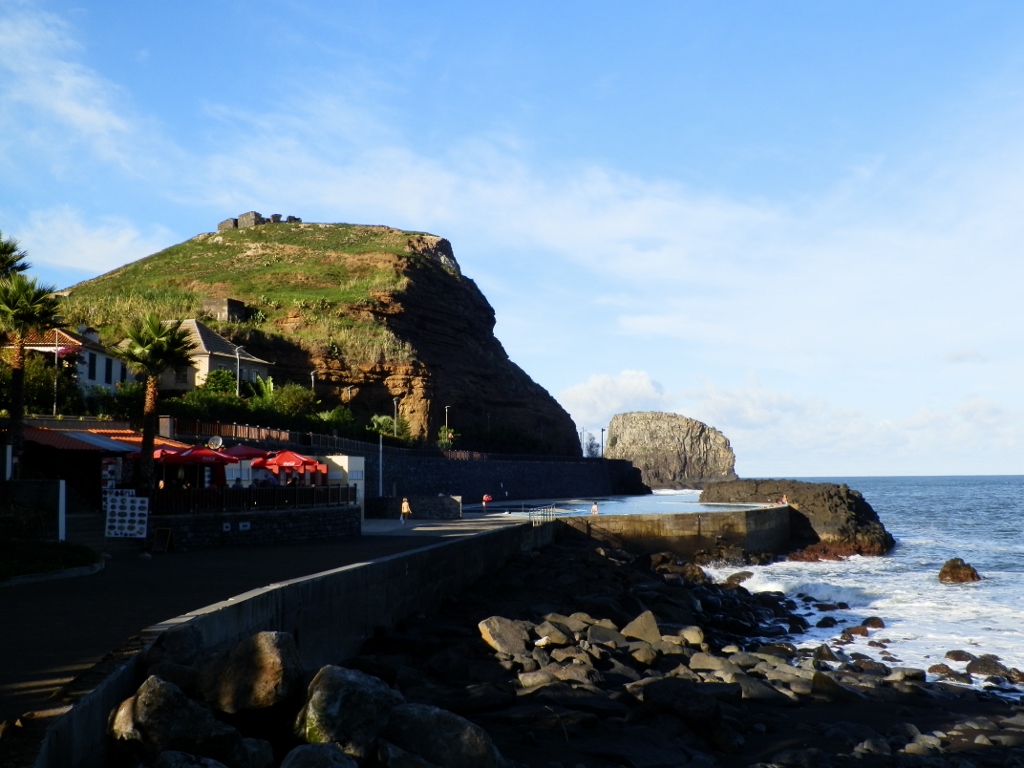 Shoreline in Porto da Cruz: restaurants and pools
Shoreline in Porto da Cruz: restaurants and pools
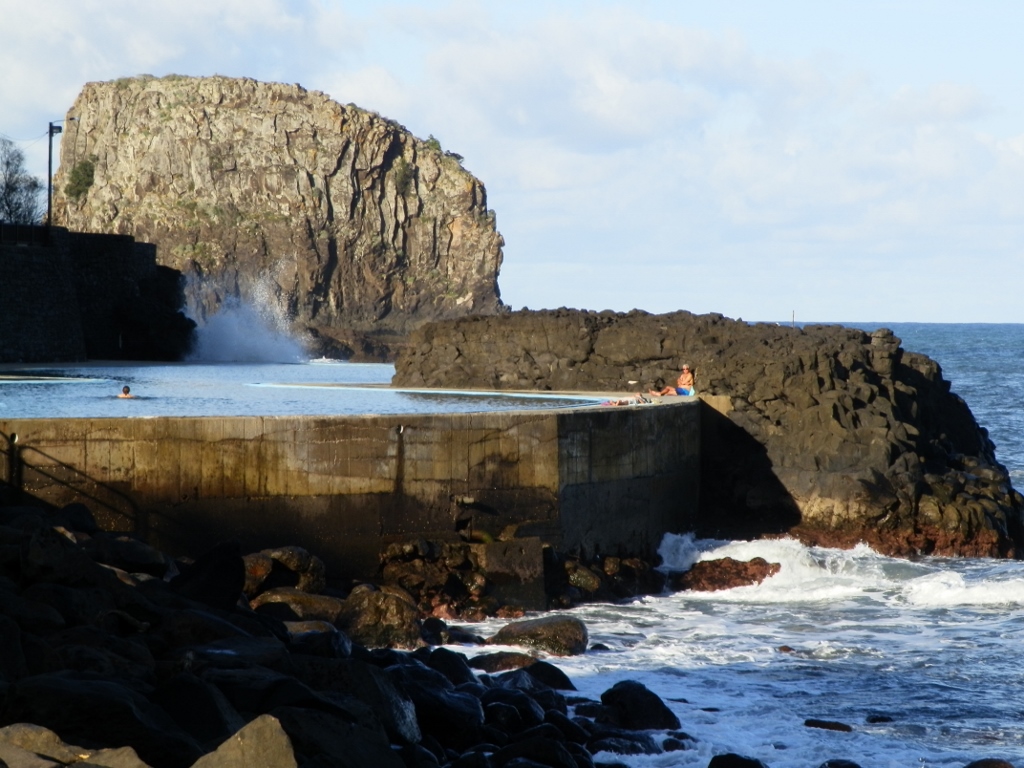 Shoreline in Porto da Cruz: the pools
Shoreline in Porto da Cruz: the pools
After this fine relaxing break, we continued with our excursion following the coastline, so soon we got to Santana, a place that has been named after the mother of Virgin Mary and it means Saint Anne.
This place is famous for its triangular houses that have thatched roofs which slope almost to the ground. Maybe these houses constituted the main architectural residential solution in the past, but today most of the houses in this town are the same as in other parts of the island, while these traditional ones are more accommodated to tourists-visitors. It does not matter. They look very cute and certainly very picturesque.
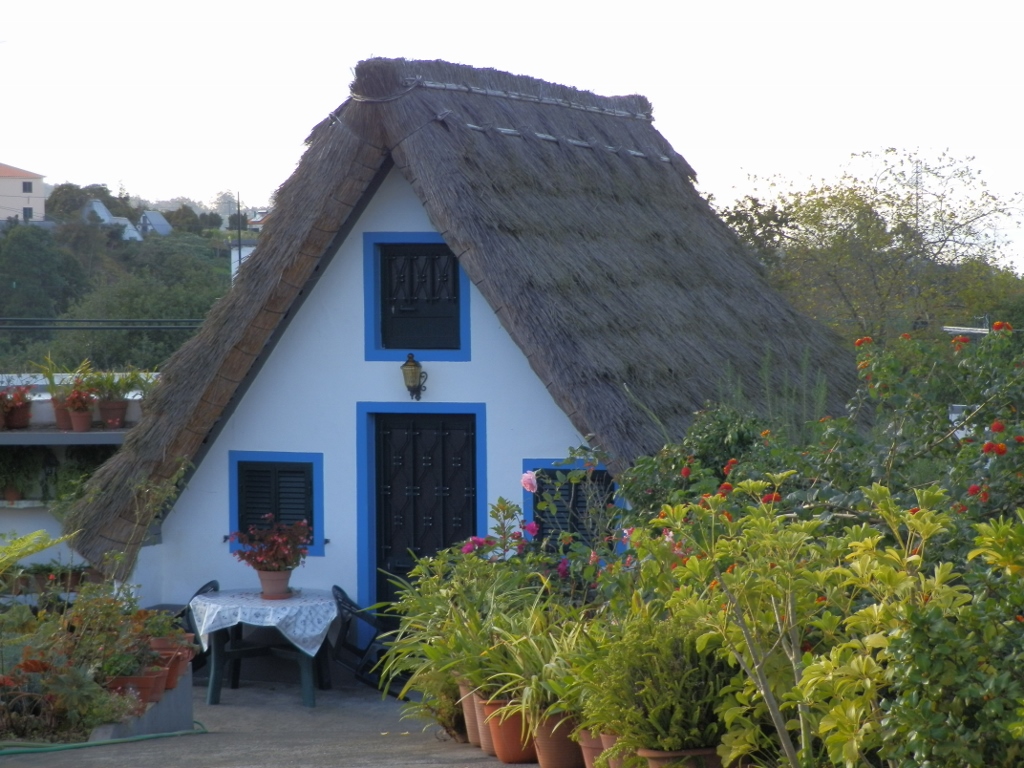 Traditional house from Santana
Traditional house from Santana
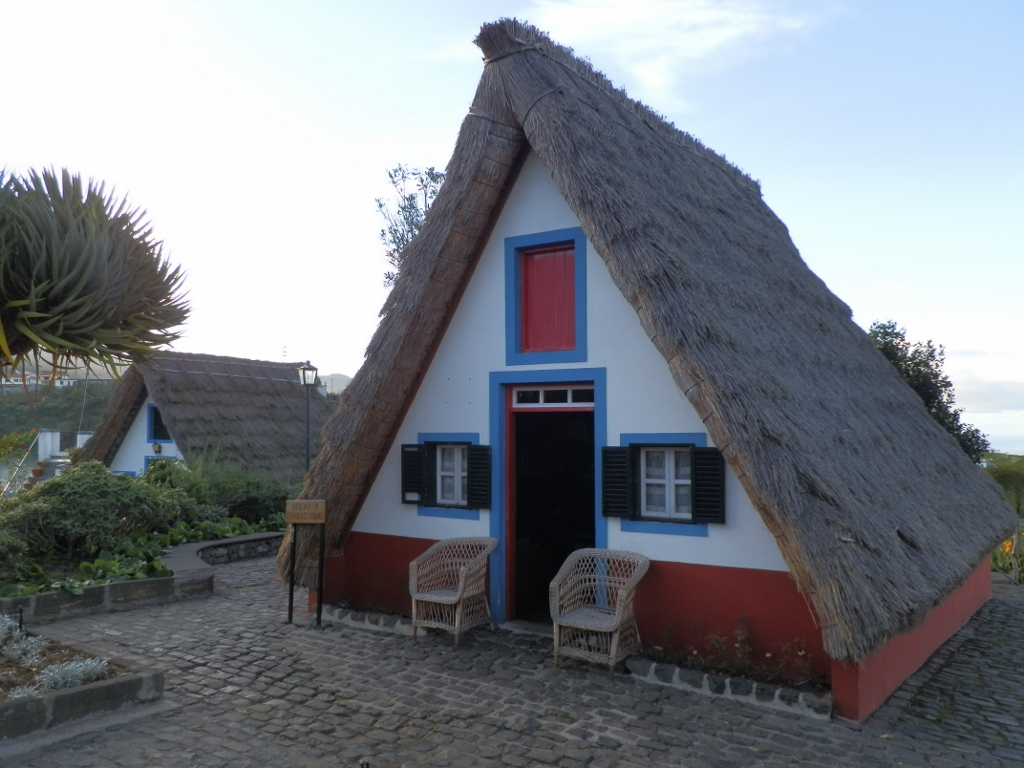 Traditional house from Santana – this one is earmarked for tourist visits
Traditional house from Santana – this one is earmarked for tourist visits
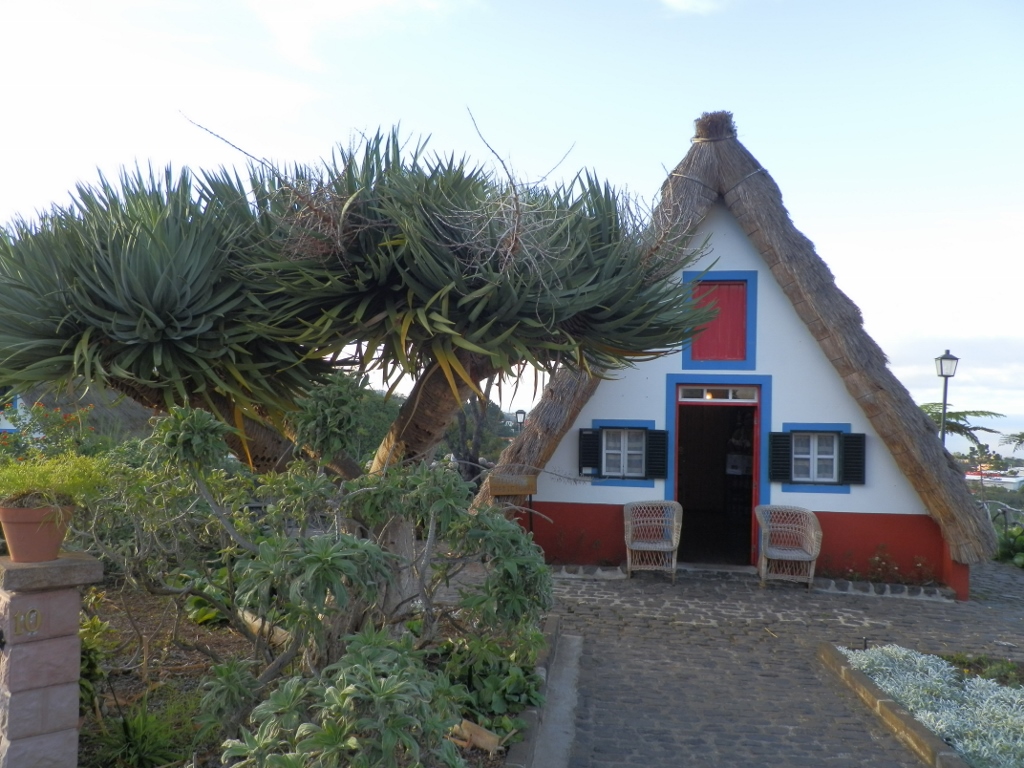 Traditional house from Santana
Traditional house from Santana
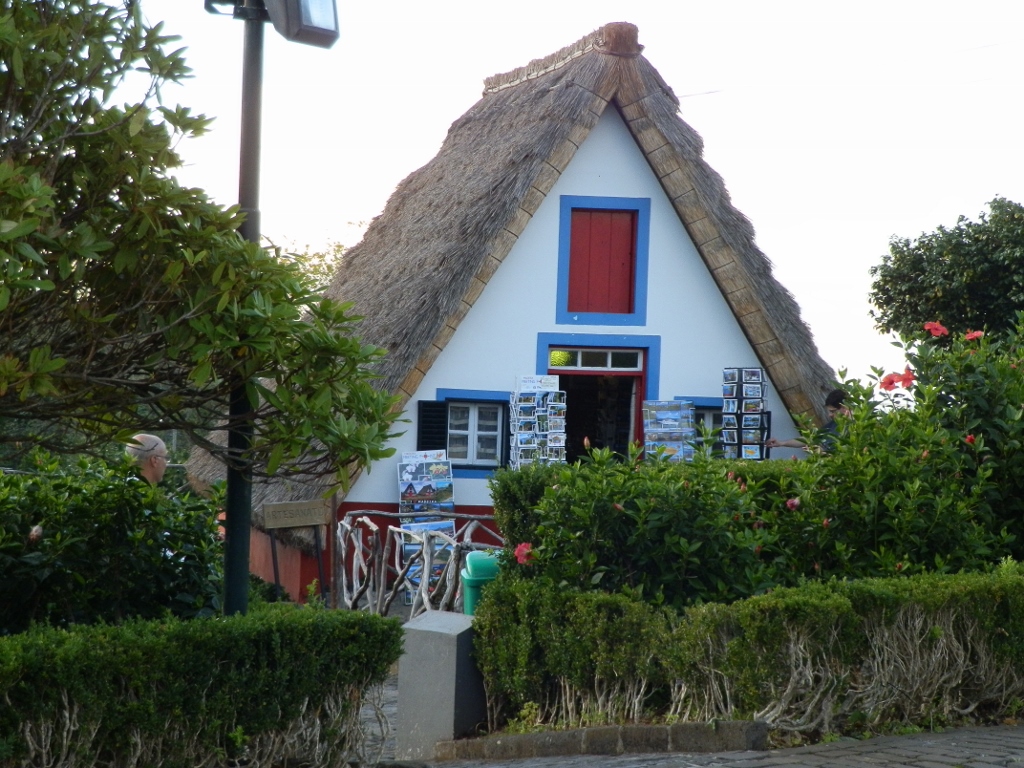 Traditional house from Santana – it is clearer here that this one is for visitors
Traditional house from Santana – it is clearer here that this one is for visitors
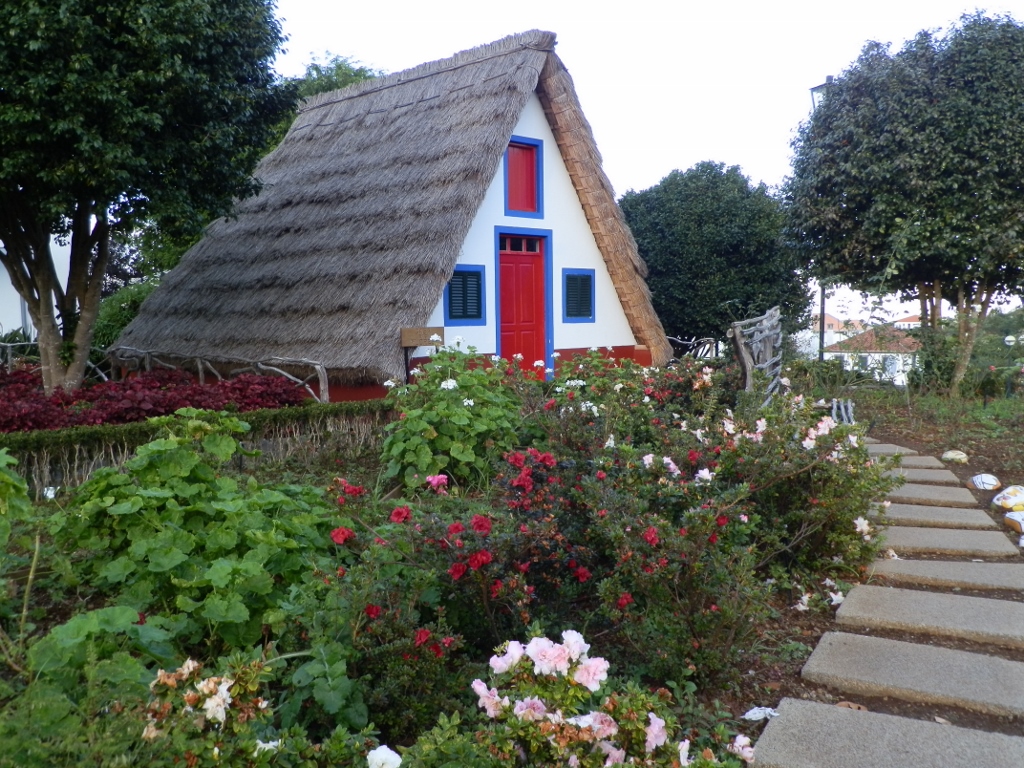 Traditional house from Santana – they do look cute, don’t they?
Traditional house from Santana – they do look cute, don’t they?
While we were in Santana, Joao and I also went to a hotel not because we felt like eating and drinking there, but because of the very interesting position of the estate on which hotel is located – the land extends to the very edge from which a steep cliff descends to the waters of the Atlantic Ocean.
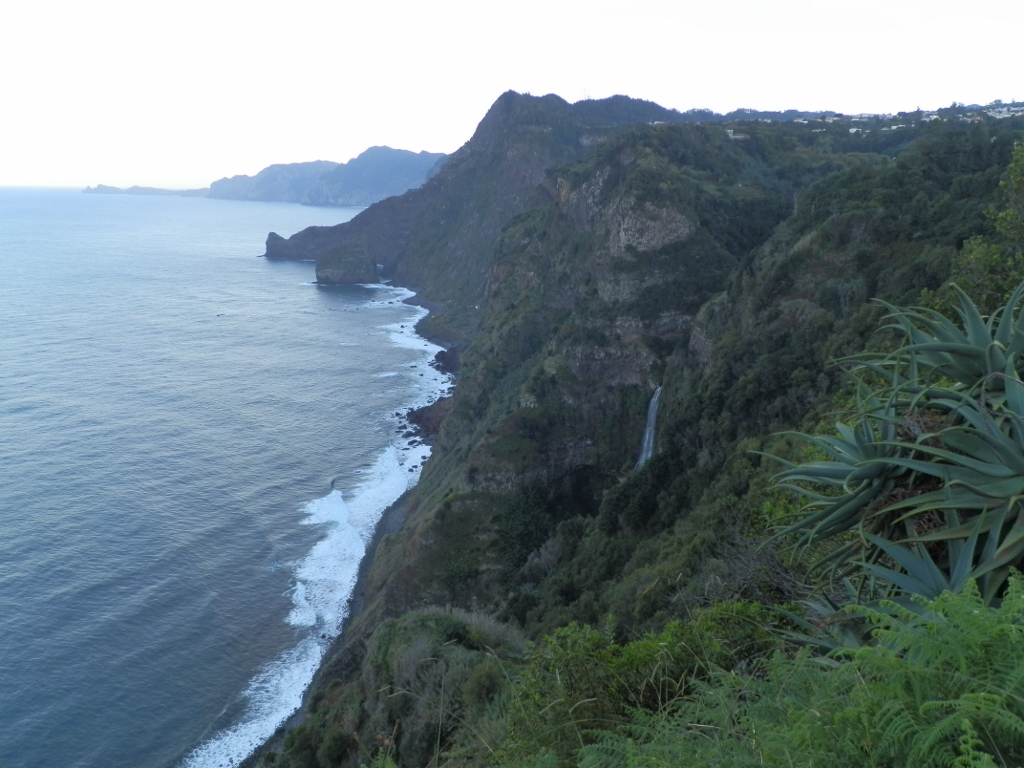 End of the estate where the hotel is
End of the estate where the hotel is
In the photo above, you can see yet another one of the numerous waterfalls that exist on Madeira. Here it is again from up close.
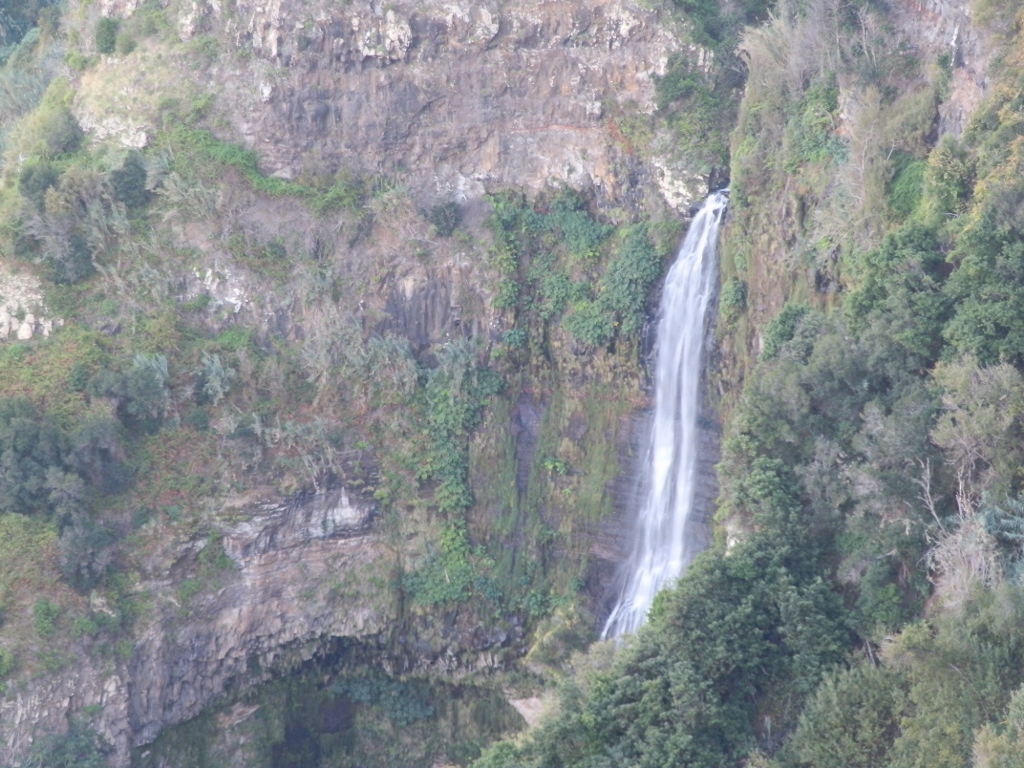 Waterfall near Santana
Waterfall near Santana
Of course, even a simple view at the Atlantic Ocean was wonderful and inspiring.
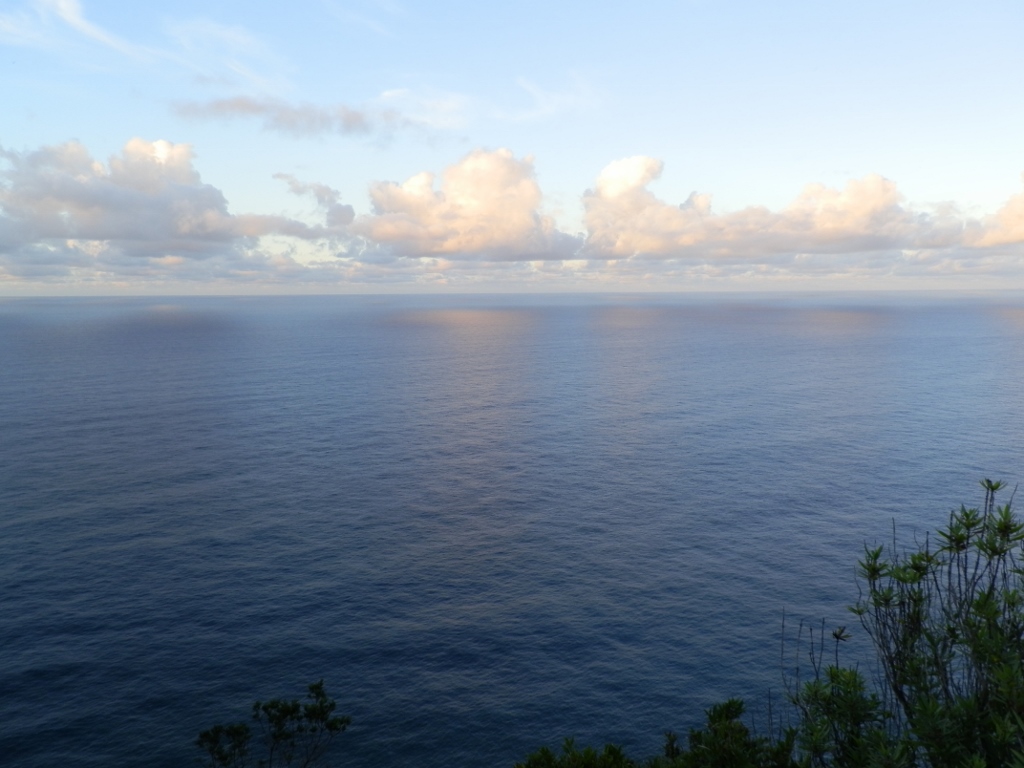 Atlantic Ocean north of Madeira
Atlantic Ocean north of Madeira
On this estate with the hotel, there is also a vineyard, as well as some nice and interesting plants.
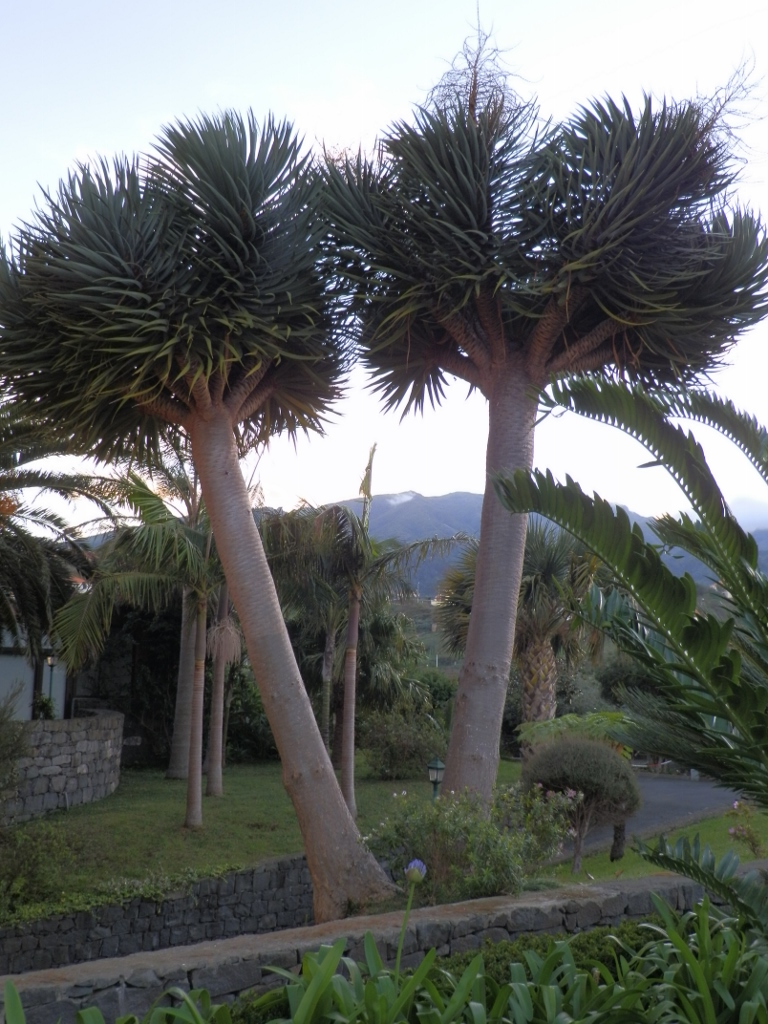 Plants at the estate of the hotel in Santana
Plants at the estate of the hotel in Santana
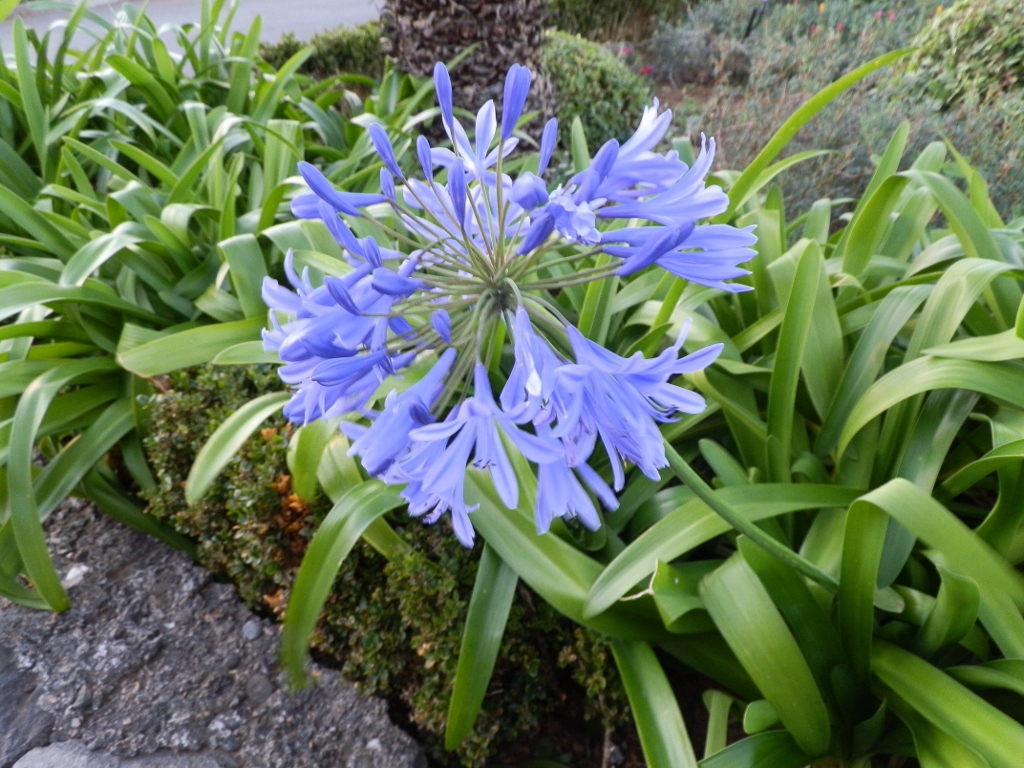 African lily (Agapanthus)
African lily (Agapanthus)
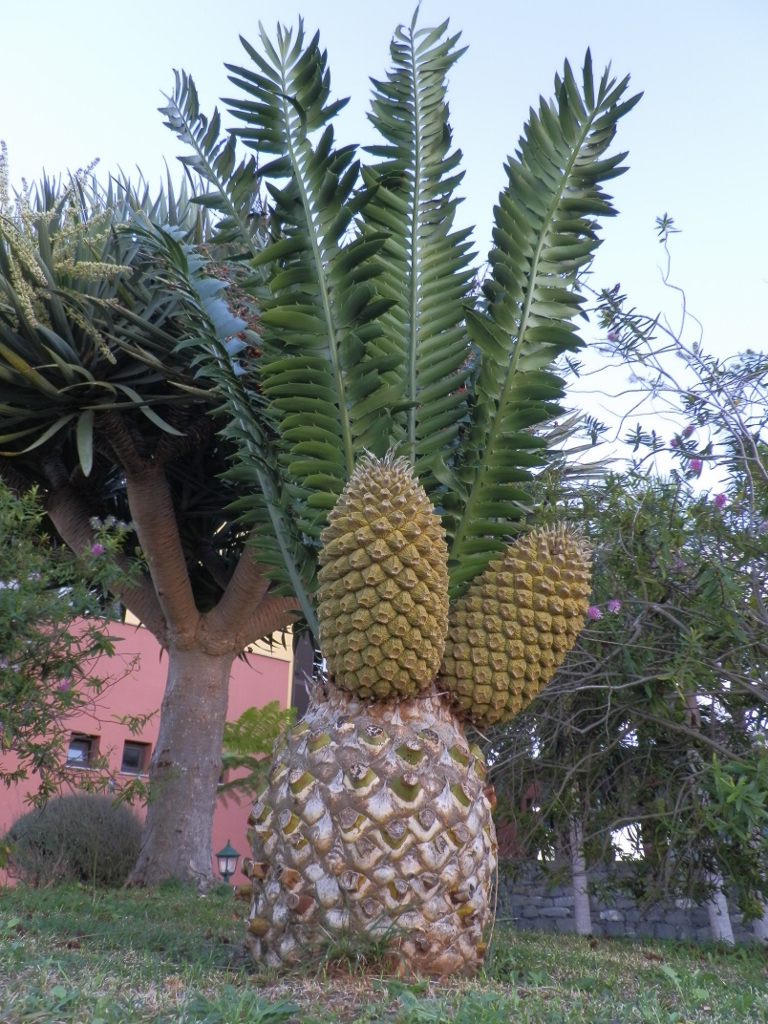 Plants at the estate of the hotel in Santana
Plants at the estate of the hotel in Santana
We walked here a little and then, before leaving the estate, we passed by yet another one of the traditionally built houses that belonged to the estate itself, but that one seemed to be in proper use.
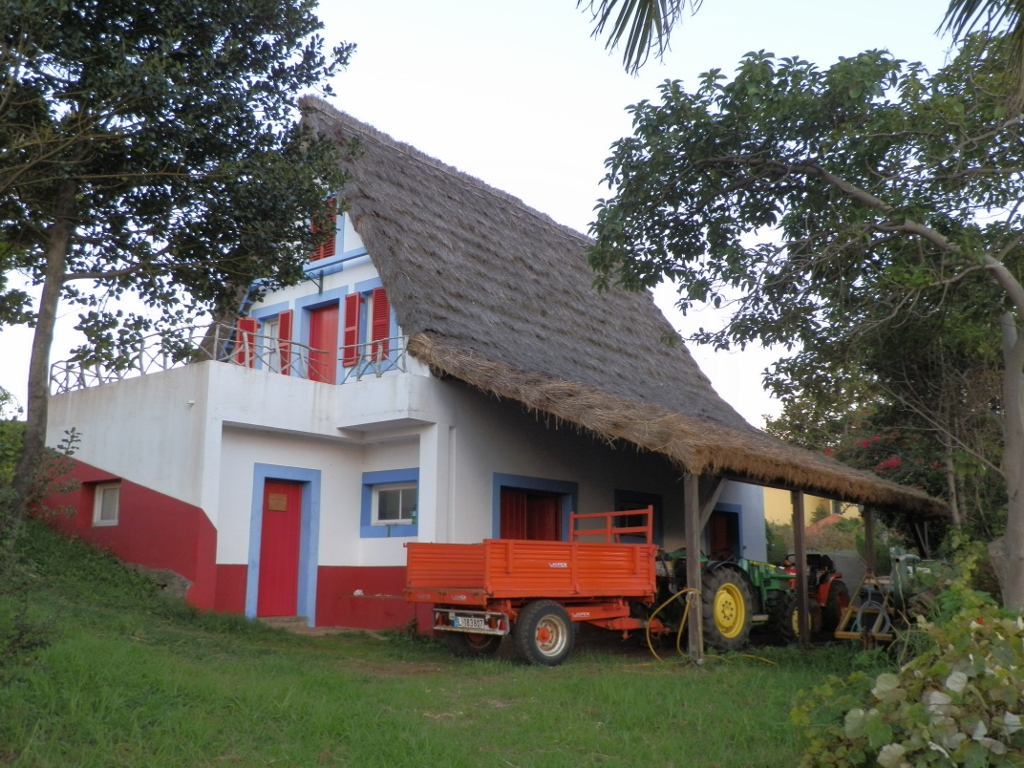 Slightly bigger traditional house from Santana that is obviously used
Slightly bigger traditional house from Santana that is obviously used
Here we completed our excursion of the day, but there was yet another important place we needed to go to before Joao took me to the hotel and that was – a supermarket. Since my body spent the entire day in two minds thinking whether it should fall ill or not, I decided to help it out and stabilise it. But, for this purpose I need an ingredient for which I (correctly) concluded I could easily get in a supermarket. This was a fresh ginger root.
When I got back to the hotel, I sat again at the terrace in front of the entrance, but this time I did not order wine and instead asked the bartender to bring me a small jug of hot water, as well as some honey and lemon. When it all arrived, using a small pocket knife that I always carry with me when travelling, I cut thin pieces of ginger and put them in the hot water. After some time, I poured the liquid into a cup. By this time the tea was less hot, but was still warm, so I added the honey and lemon. It was wonderful and tasty and the next day I woke up completely healthy, in good mood and ready for a new excursion.
Joao came to pick me up again and on we went.
First we practically climbed a hill by car going to yet another fine viewpoint, Pico dos Barcelos Lookout (Miradouro Pico dos Barcelos) made in 1950 at the altitude of 355 m in the parish of Santo António, which is a part of Funchal.
In the centre of this place there is an elevation with a cross and from there it is also possible to have nice views of the surroundings, while around this central elevation there is a terrace-like area with fine views at Funchal and its bay.
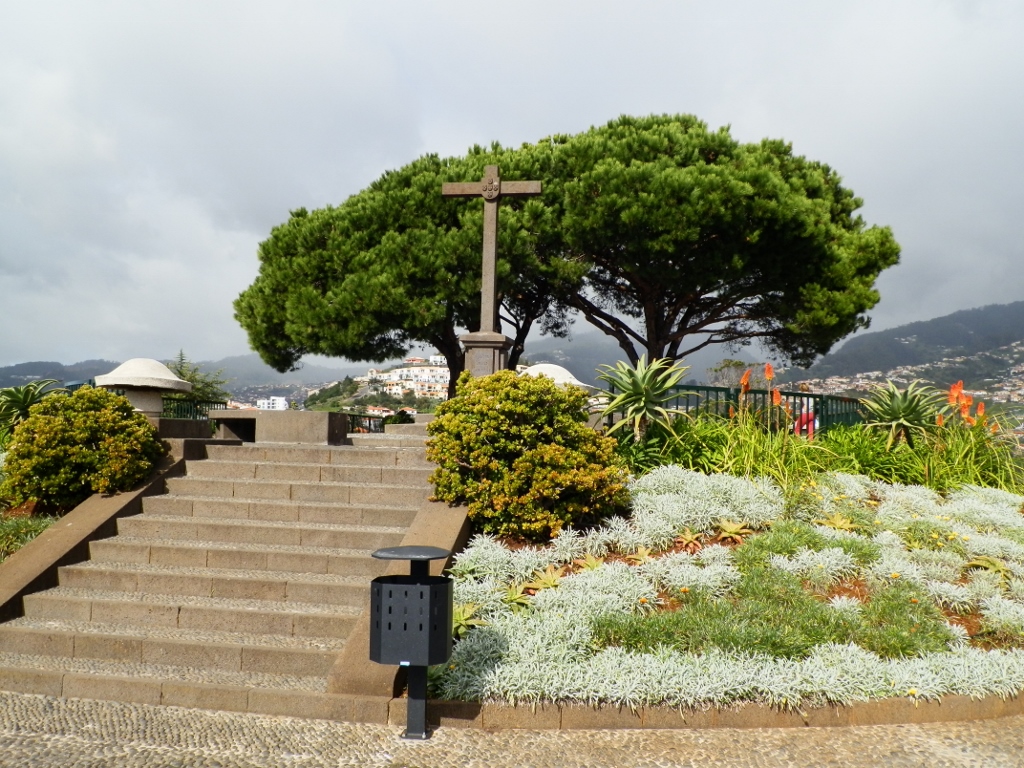 Central part of the Pico dos Barcelos Lookout
Central part of the Pico dos Barcelos Lookout
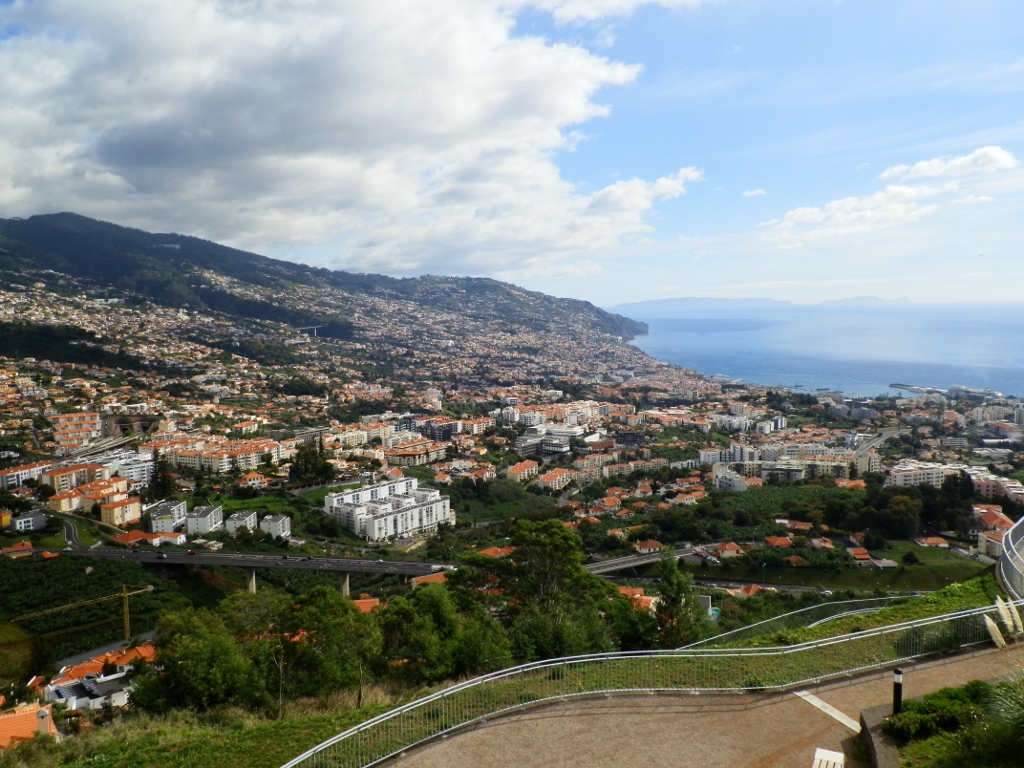 View at Funchal from the Pico dos Barcelos Lookout
View at Funchal from the Pico dos Barcelos Lookout
Obviously, there are many places on Madeira with constructed viewpoints, but this is neither strange nor too much. Thanks to its hilly and mountainous structure, one often finds oneself on an elevation and as the island is green, beautiful, surrounded by an impressive ocean and provides wonderful sights, then it is also very convenient to have specific places from which one can enjoy these vistas in peace.
At this site there are also a lot of plants and some of them were in full bloom which I liked very much, so I was completely immoderate when it came to taking photos.
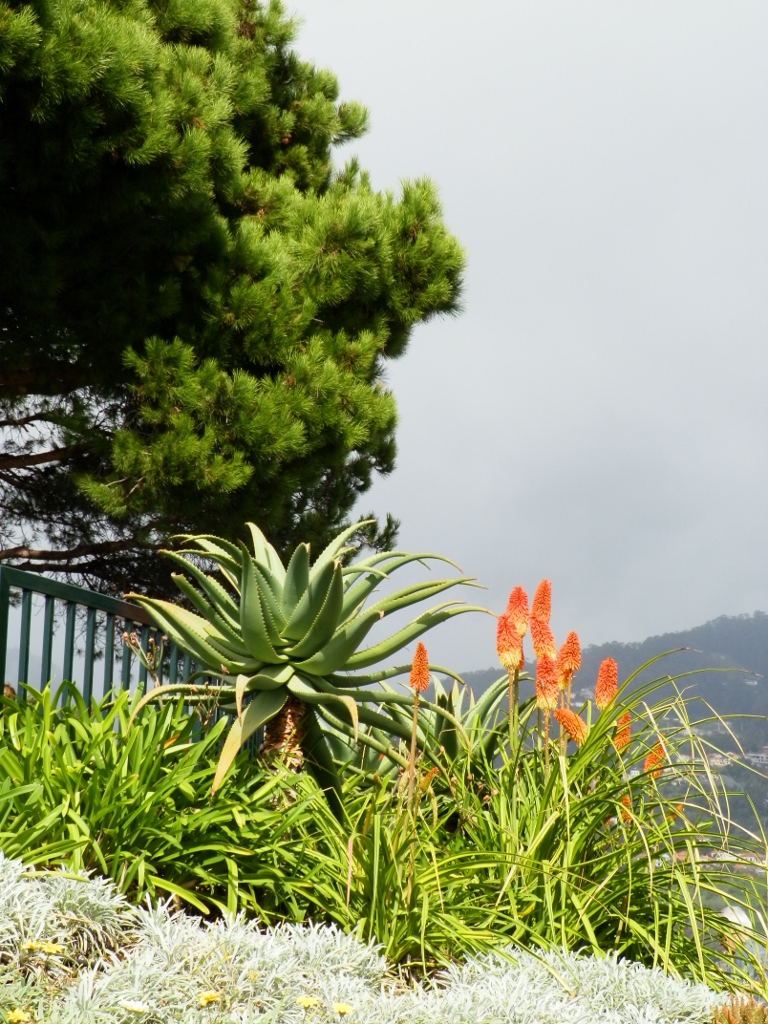 Decorative plants at the Pico dos Barcelos Lookout
Decorative plants at the Pico dos Barcelos Lookout
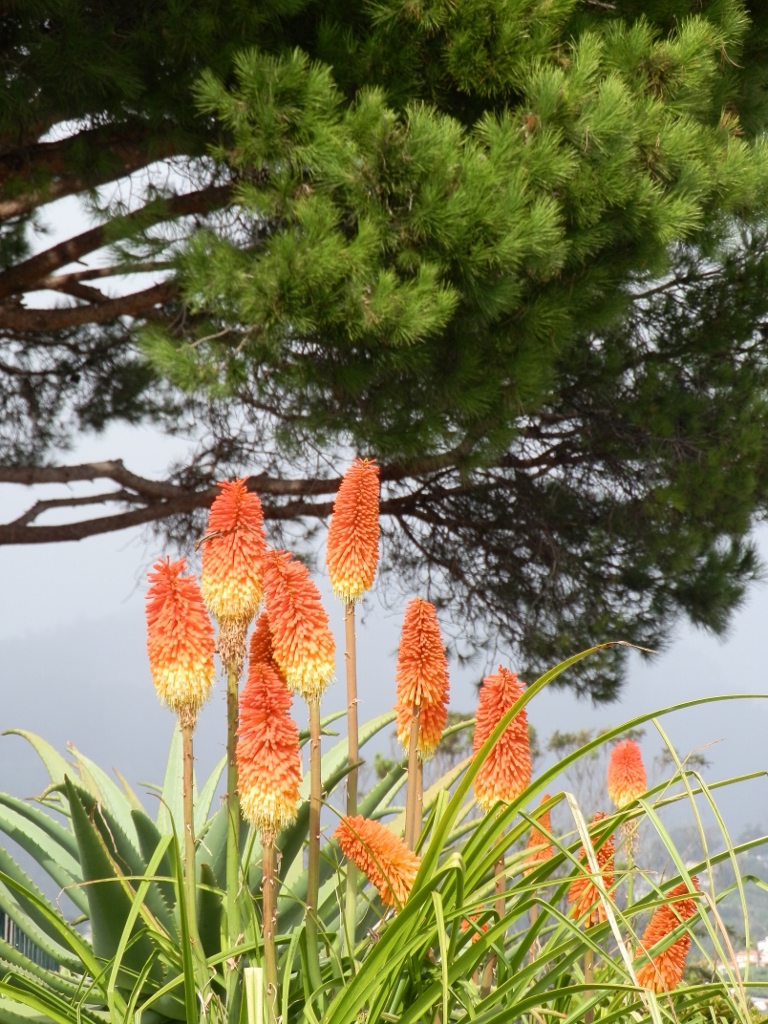 Torch lily or tritoma (Kniphofia) at the Pico dos Barcelos Lookout
Torch lily or tritoma (Kniphofia) at the Pico dos Barcelos Lookout
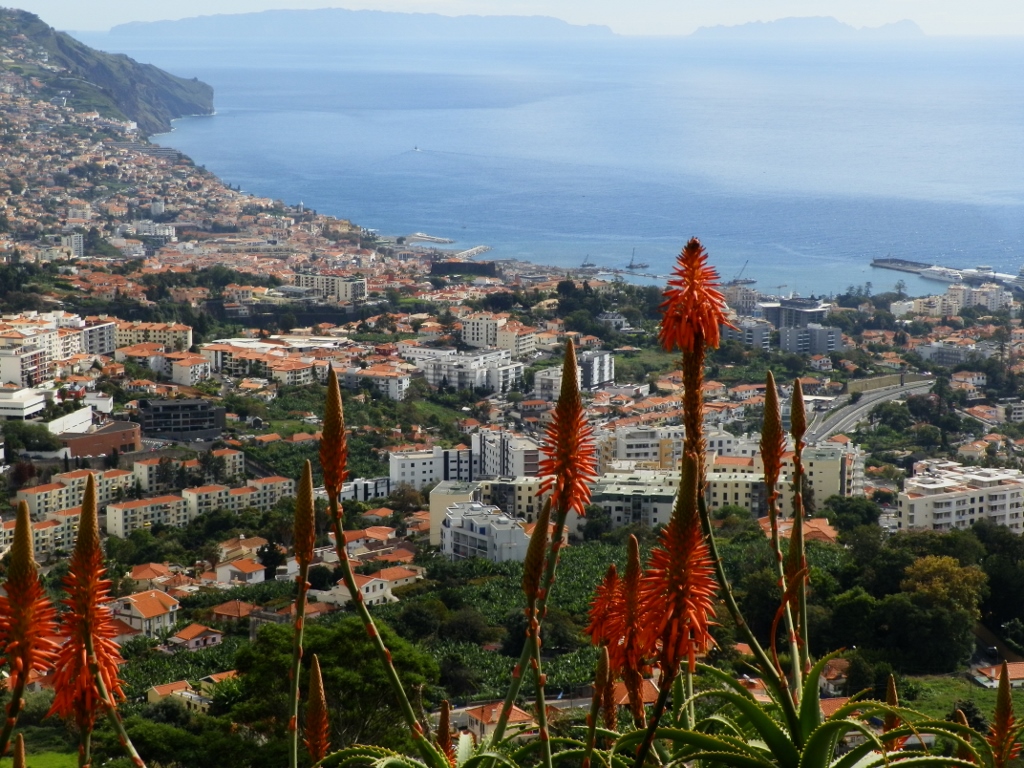 View at Funchal adorned with flowers
View at Funchal adorned with flowers
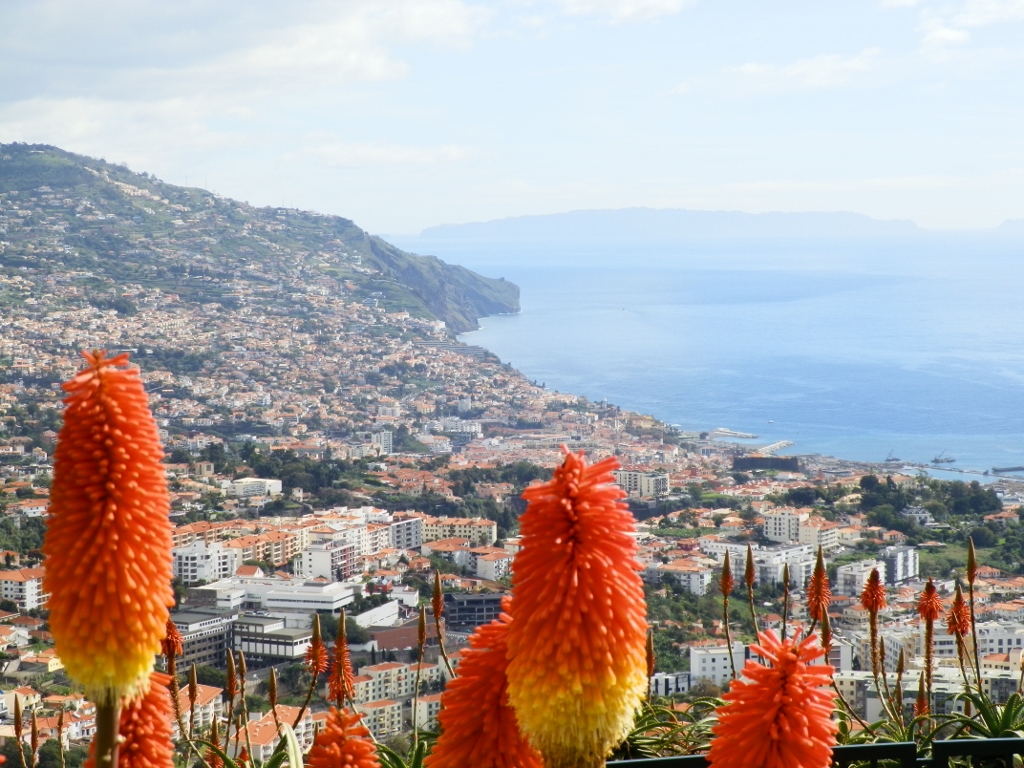 View at Funchal adorned with flowers
View at Funchal adorned with flowers
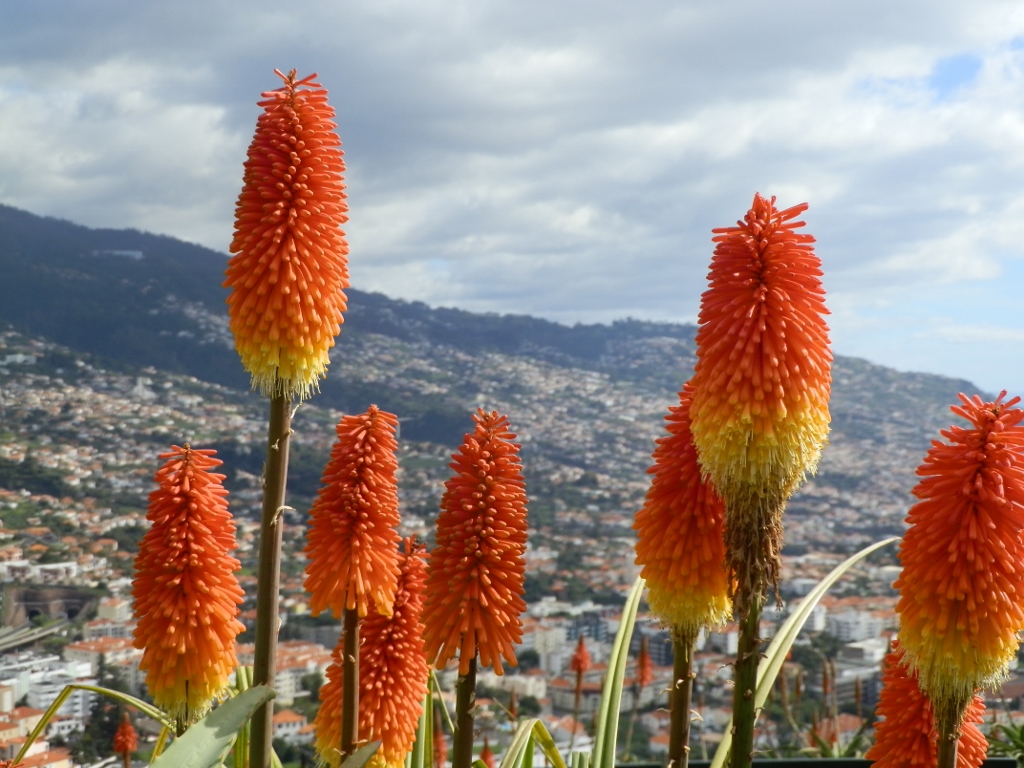 The flowers are now in the focus, while parts of Funchal serve only as the background
The flowers are now in the focus, while parts of Funchal serve only as the background
Then Joao took me to a place where there was a workshop, as well as a shop of local honey cakes, sweets and biscuits.
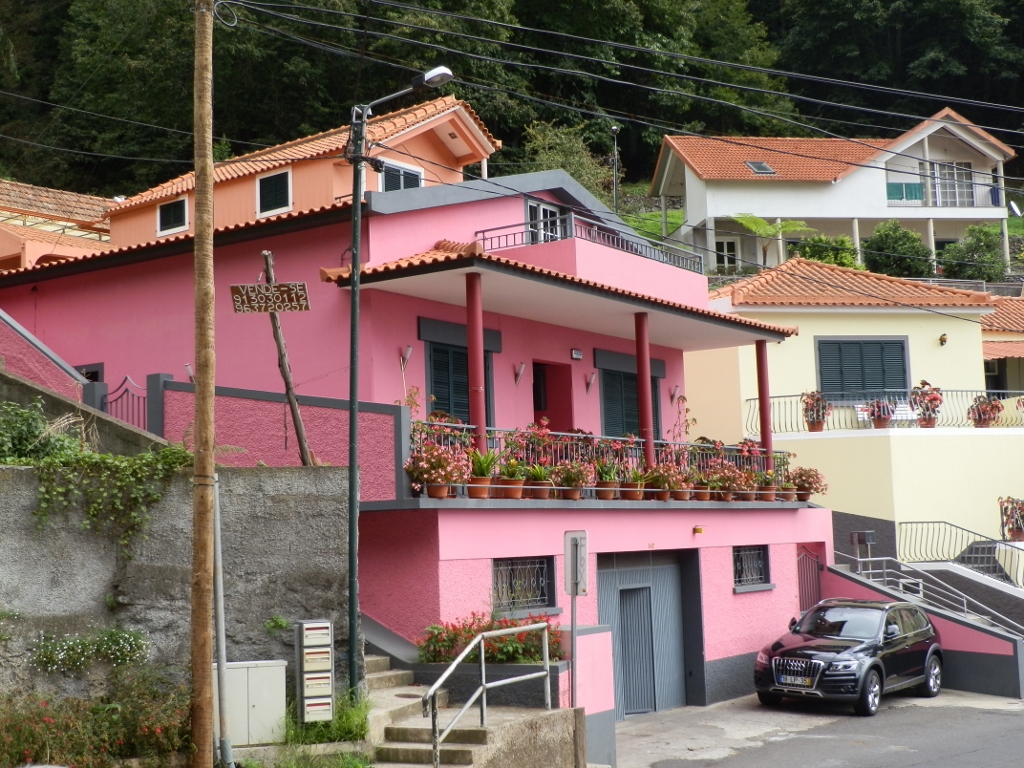 This is the empire of the production and sale of traditional sweets
This is the empire of the production and sale of traditional sweets
Namely, one of the well-known traditional sweets from Madeira is the honey cake (Bolo de Mel). The main ingredient is the sugarcane honey and traditionally the preparation of this cake is linked to Christmas. For this purpose it is made already on 8 December, the Day of Our Lady of Conception, since the cake can stay for a few weeks without losing anything of its quality. On the other hand, nowadays this cake can be found in shops throughout Madeira at any time of the year.
Here we entered the garage of the house seen in the photo above, since this was the place where the workshop was, so I could see different phases linked to the preparation of the cakes.
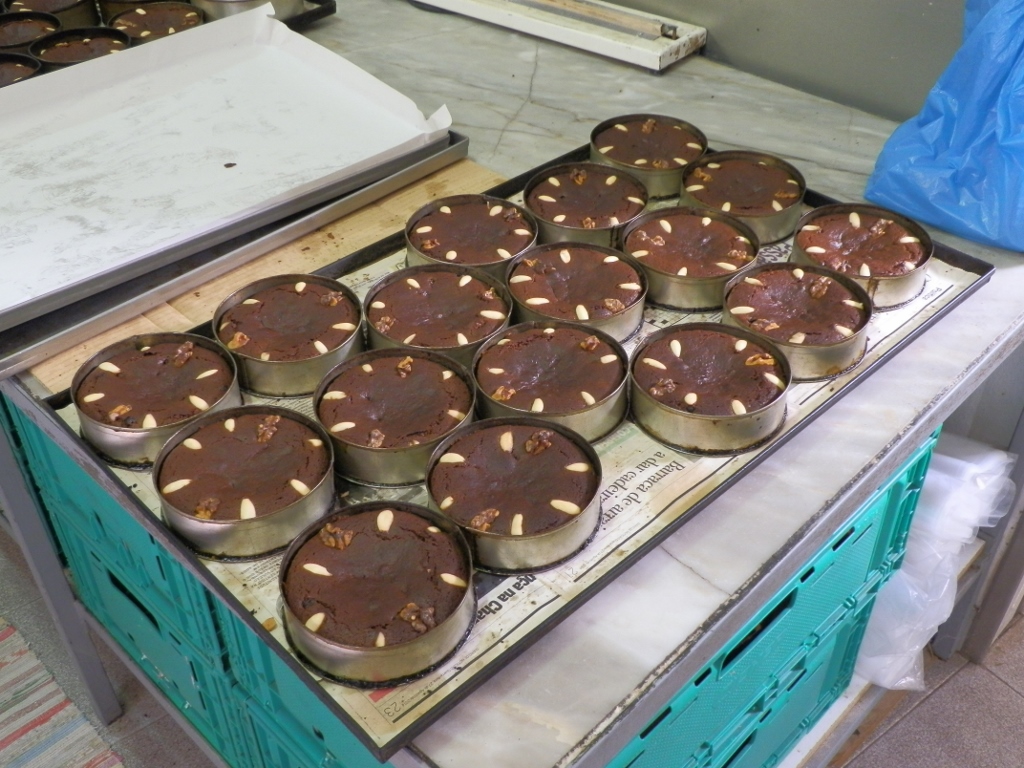 Honey cakes
Honey cakes
There is also a selling area with an assortment that also included biscuits made of coconut, honey or chestnut, as well as traditional fennel candies called Rebuçados de Funcho. I found it interesting to hear the story that João Gonçalves Zarco, the explorer who had discovered Madeira, was impressed by the quantity of the plants with yellow blossoms that grew around the bay where he founded the first settlement. This plant was fennel and since the Portuguese word for fennel is funcho, Zarco called the new settlement – Funchal, the present-day capital of Madeira. Since the medicinal properties of fennel had been known from before and the plant grew in abundance here, with time they started to make candies in order to take advantage of this good combination – healthy and plentiful.
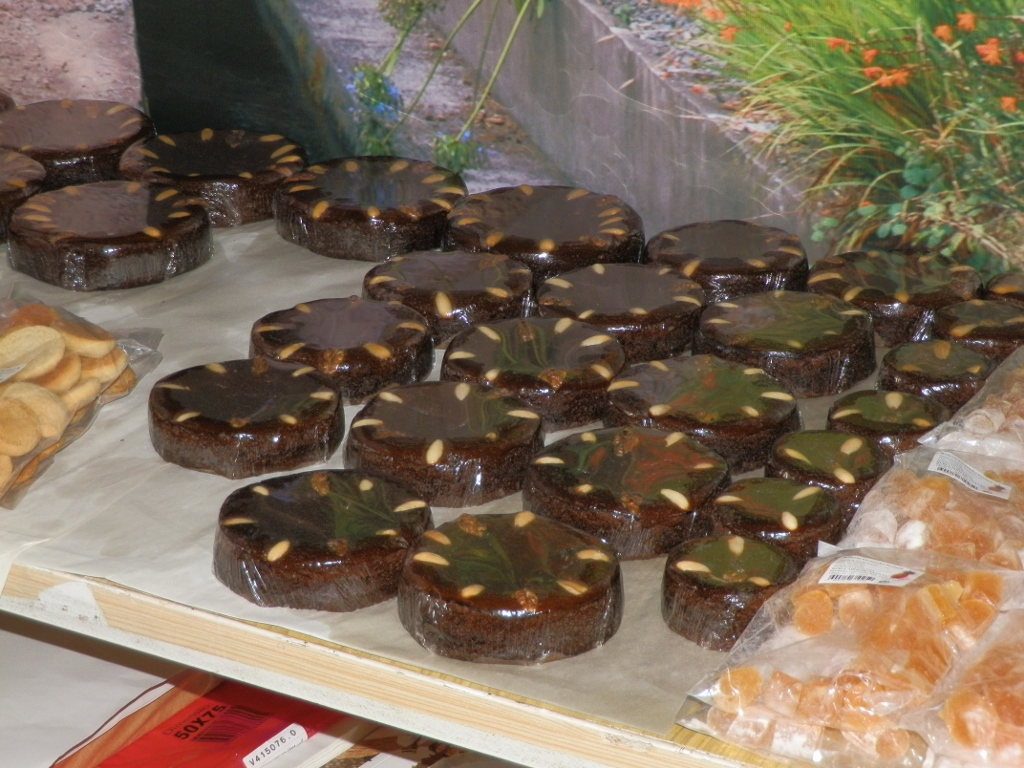 Shop’s display: packed honey cakes and fennel candies (on the right-hand side)
Shop’s display: packed honey cakes and fennel candies (on the right-hand side)
Here I bought a couple of products to take home and I was also offered to taste an alcoholic drink called ginja. This is a local version of cherry brandy but, in addition to cherries and sugar, cloves and/or cinnamon sticks are added to aguardente used as the base. It was tasty!
As it could be seen in some of the photos above, although there were some clouds in Funchal, we left the city in the predominantly sunny and dry weather. However, as Joao and I were going towards the interior of the island driving through a dense eucalyptus forest, the quantity of clouds was increasing or we were just passing through not too dense, but certainly omnipresent fog. We were heading for a small and beautiful place called Curral das Freiras, but before getting to the village itself, we went up to a hotel located in the mountains above the village. There we left the car and agreed Joao would wait for me to have coffee together at the hotel, while I dashed up to a nearby viewpoint. The reasons for my “dashing” was that all the time there was quite intensive drizzle and we did not have an umbrella. Admittedly, I had my jacket with a hood on, but that was not particularly helpful on account of the wind, so my glasses were quite spattered. Still, each and every moment I spent here was magical primarily because of an incredible phenomenon I witnessed here that could also be seen already near the hotel.
It concerned a rainbow, but a rainbow that I could see from ABOVE.
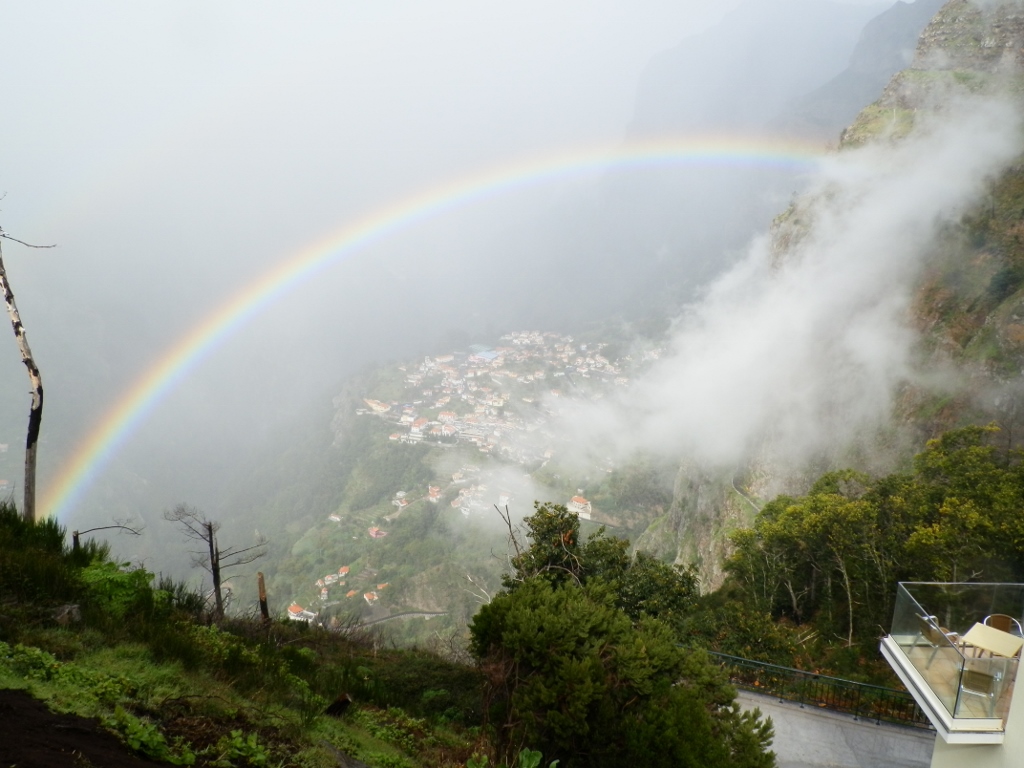 Rainbow above Curral das Freiras
Rainbow above Curral das Freiras
Village Curral das Freiras, which I will say a bit more about a little later, is situated in a narrow and deep valley, surrounded from all sides by high and very steep mountains. The hotel we went to had been built on one spot above the village and from it a fenced concrete path leads to a likewise fenced platform called the Eira do Serrado viewpoint. It is located at the altitude of 1095 m a.s.l.
When the weather is fine, with no clouds, one can really enjoy the gorgeous forested heights of the surrounding mountains and that natural almost funnel-like shape of the valley in which this village is located. This time, however, those heights were covered in pockets of fog.
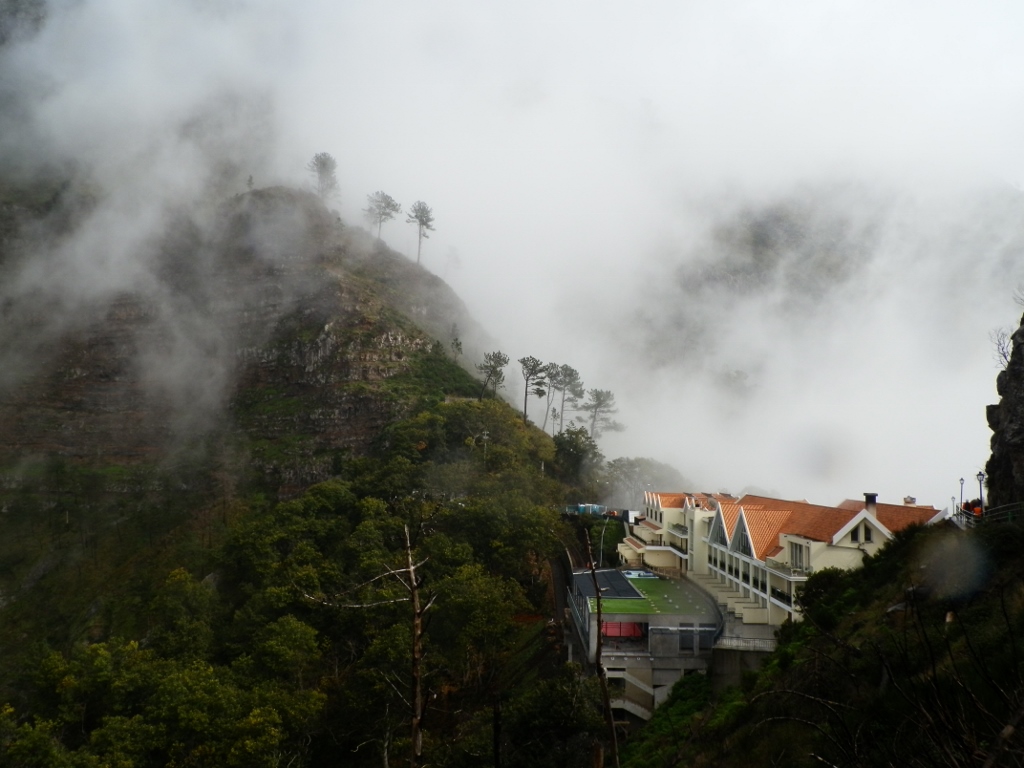 Hotel near the Eira do Serrado viewpoint
Hotel near the Eira do Serrado viewpoint
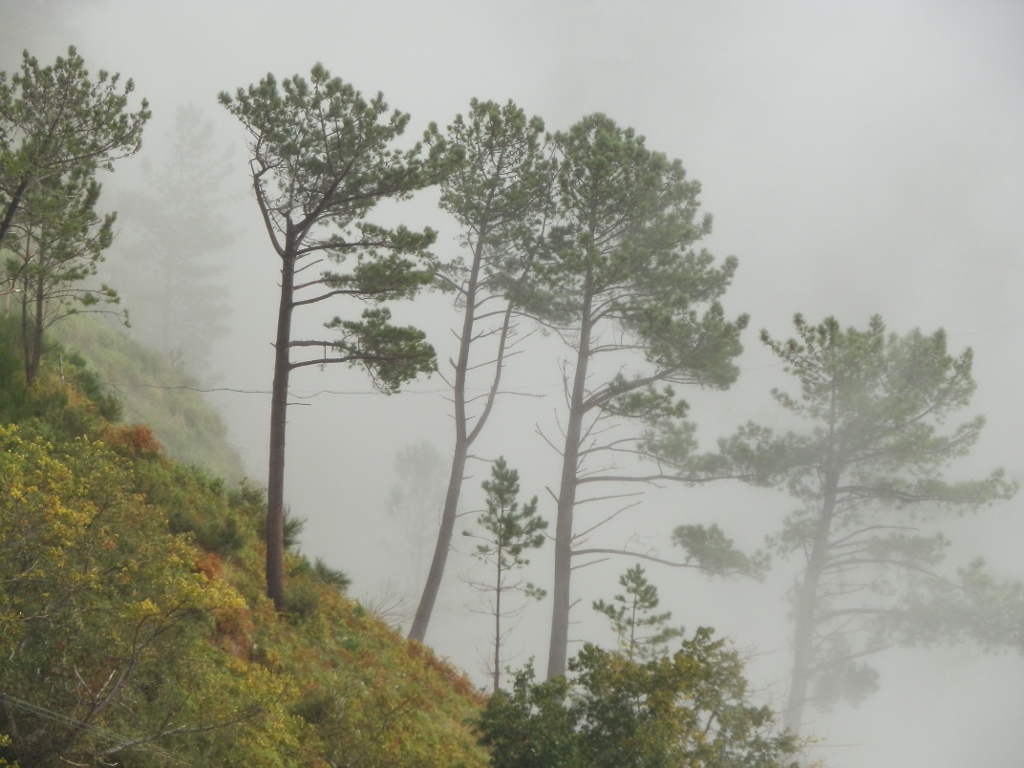 Surroundings of the Eira do Serrado viewpoint in cloudy/foggy weather
Surroundings of the Eira do Serrado viewpoint in cloudy/foggy weather
But, this fog, the drizzle and the thin clouds through which the sunshine somehow passed did not impede the experience in the least. Quite the contrary! Thanks precisely to this combination of weather elements already from a point near the hotel I could see a very intensive rainbow and it remained in its place even when I got up to the platform. In order to take better photos, I leaned over the fence and all the angles I took were spectacular while I could not wipe the smile off my face.
And so, to start with, I saw the infamous end of the rainbow – it was on the cliff right under my feet, but it was clear to me that the pot of gold would have to wait for somebody else and some other opportunity.
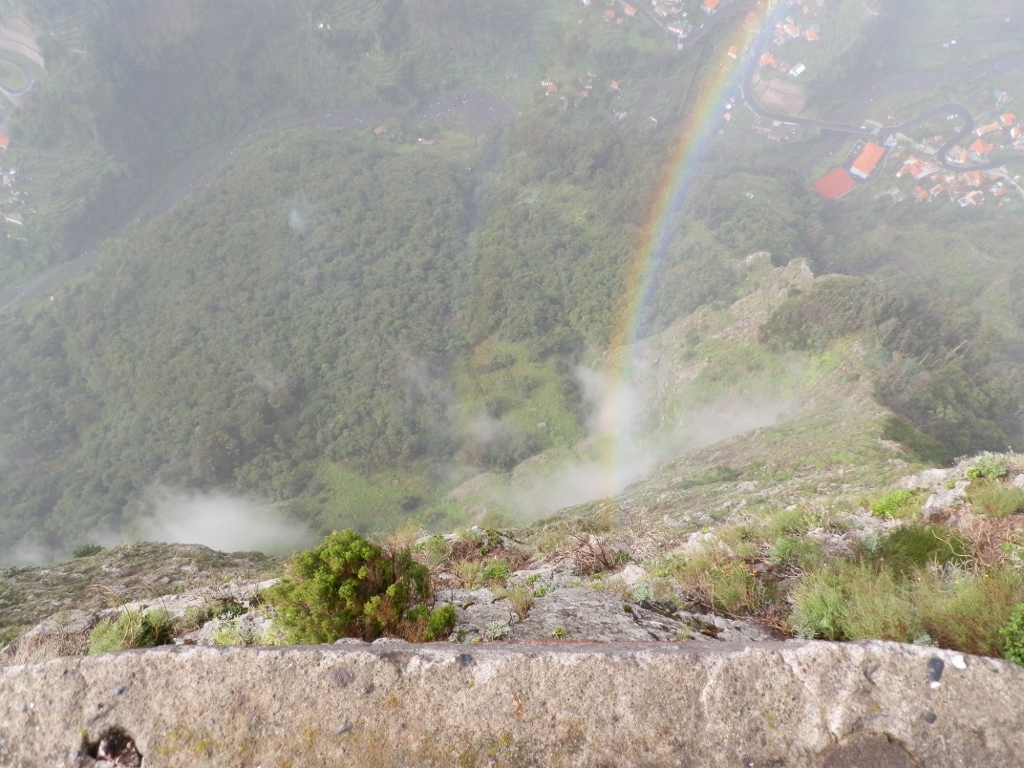 Here is the end of the rainbow
Here is the end of the rainbow
As I moved along the platform, the rainbow was vertically right below me and above the houses at the foot of the mountains.
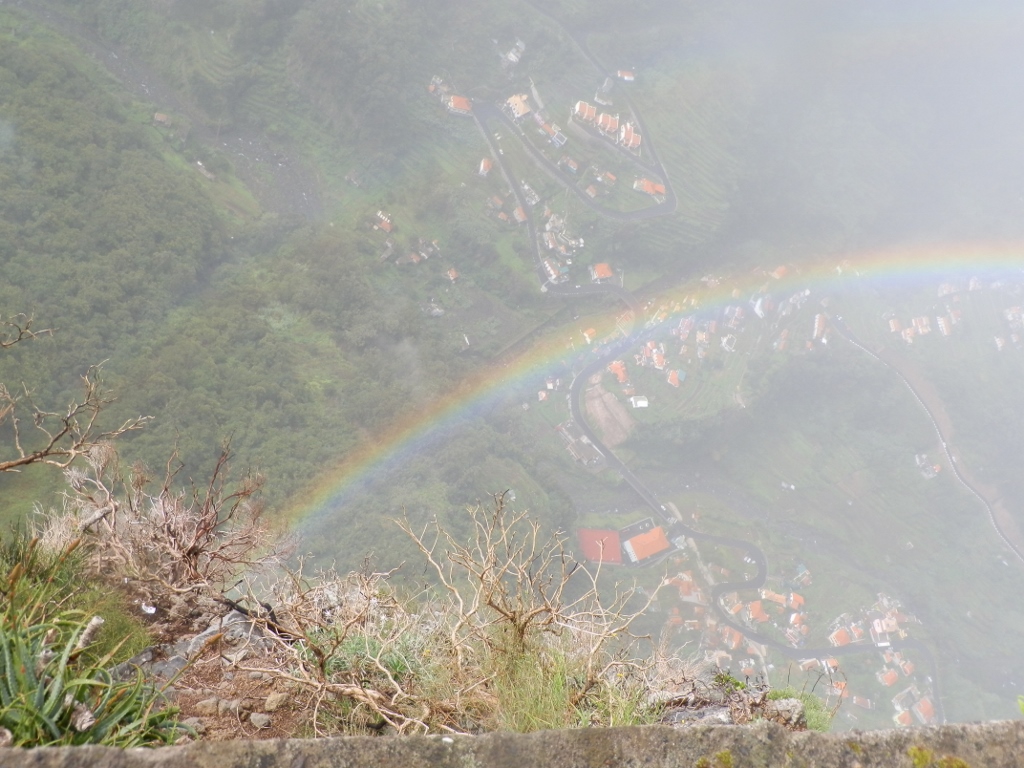 This is what it looks like to be “Somewhere over the rainbow...”
This is what it looks like to be “Somewhere over the rainbow...”
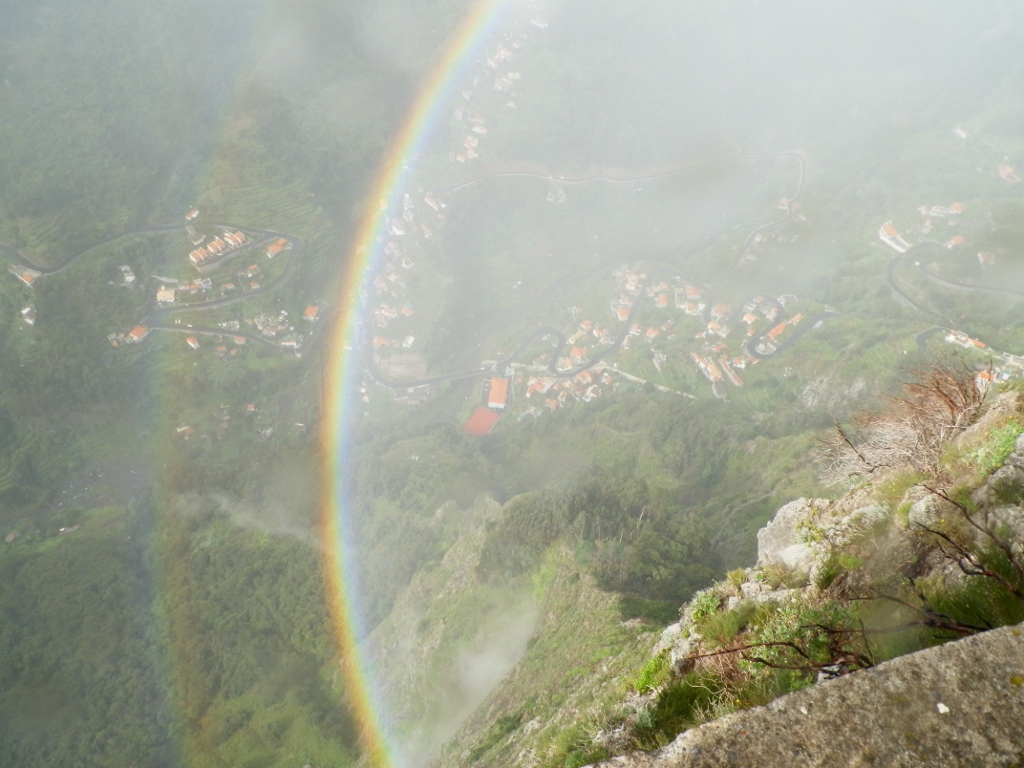 This is what it looks like to be “Somewhere over the rainbow...”
This is what it looks like to be “Somewhere over the rainbow...”
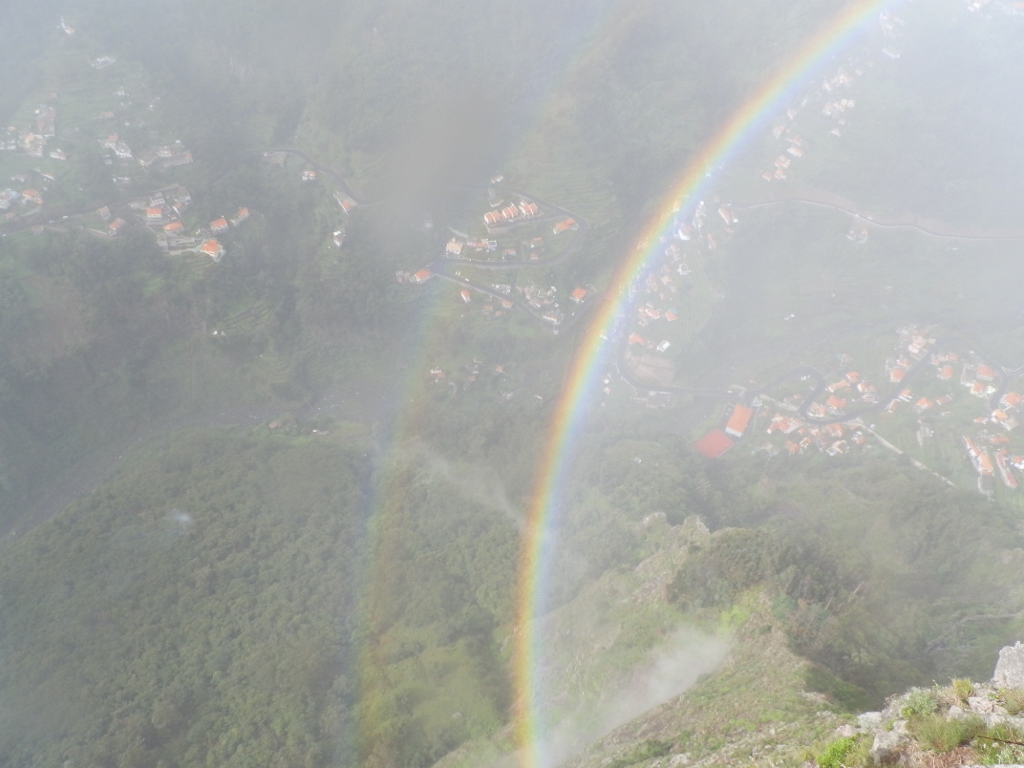 This is what it looks like to be “Somewhere over the rainbow...”
This is what it looks like to be “Somewhere over the rainbow...”
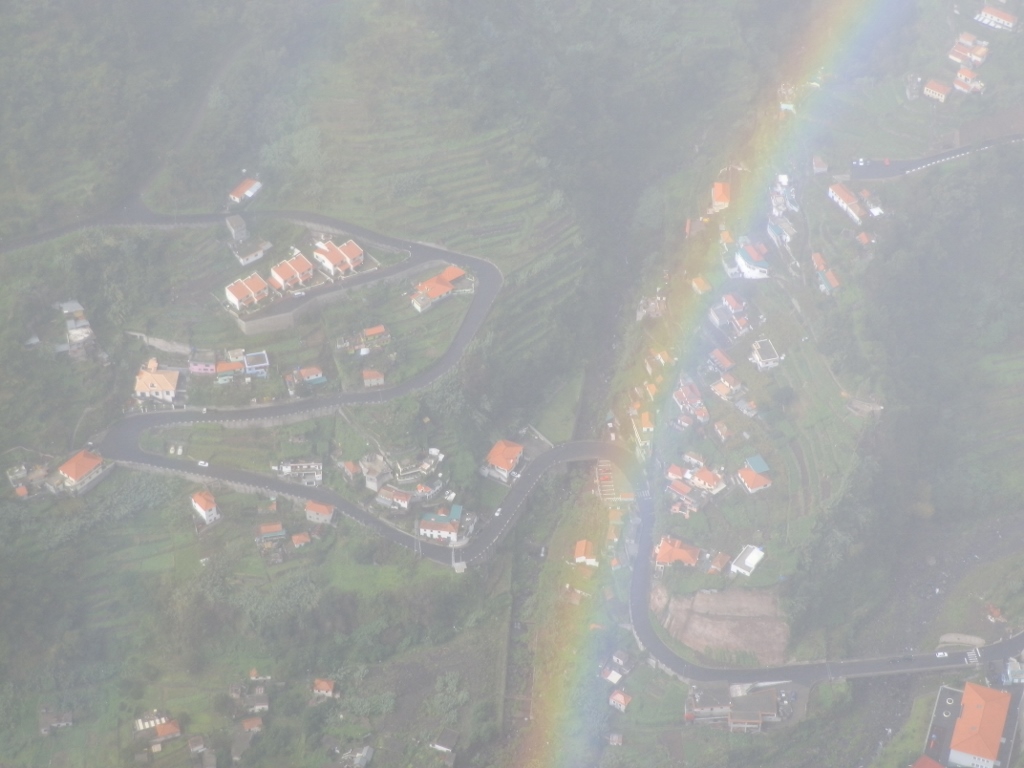 As if I were floating above the road and the houses, with the rainbow in-between – MAGICAL!!!
As if I were floating above the road and the houses, with the rainbow in-between – MAGICAL!!!
Inspired by this experience and my position over the rainbow I treated myself to a suitable mini-concert. I struggled with the lyrics a bit, but it turned out well in the end. Also, I haven’t published a “mlog” (music blog) for quite a while, so here it is.
Then I took one more photo of Curral das Freiras, after which I went back to the hotel where Joao and I had our coffees.
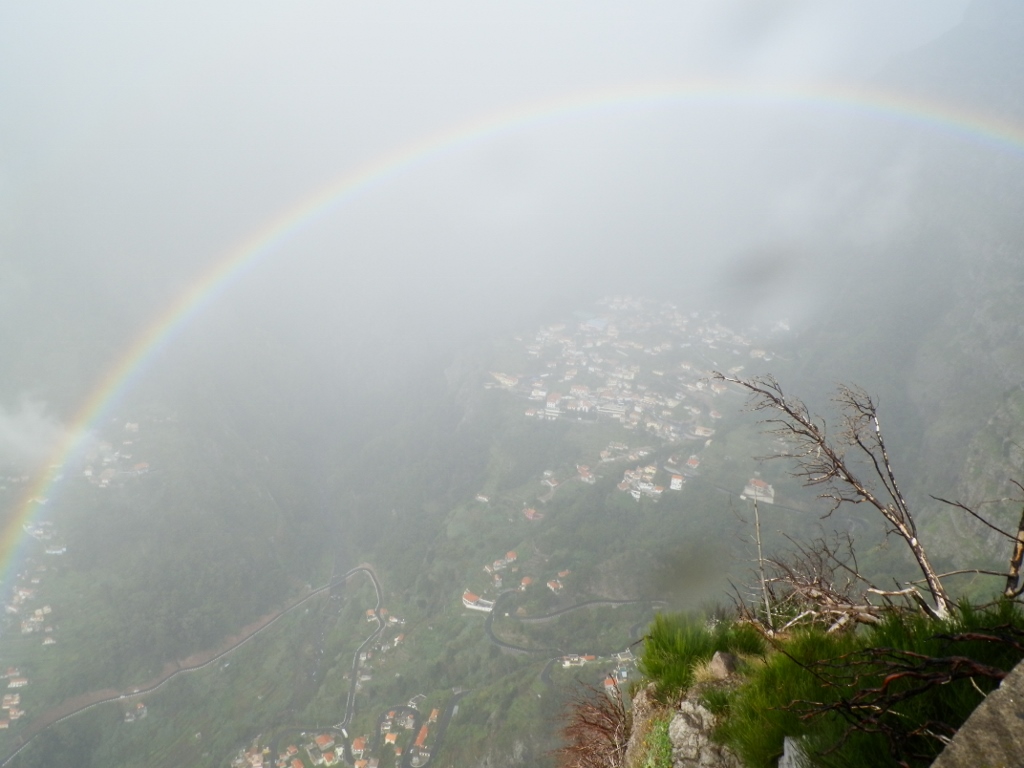 Rainbow above Curral das Freiras (there are raindrops on the lens of my camera)
Rainbow above Curral das Freiras (there are raindrops on the lens of my camera)
While we were waiting for the coffee, I looked around the hotel bar a little and was impressed by the diversity of liquors used here and produced on Madeira. In addition to the ready-to-use and bottled poncha, I also saw liquors made of eucalyptus, fennel, Surinam cherry, loquat, pennyroyal, chestnut... Among other flavours, there was also passion fruit liquor and it was only by seeing the label with a photo of the plant that I realised that this was the fruit of the Passiflora edulis plant often grown in non-tropical climates for its flowers and as a decorative plant.
After the pleasant coffee break, we went down to Curral das Freiras. The name of the village means Nuns’ Refuge and the reason for such a name is that in 1566 when pirates attacked Funchal nuns from Santa Clara convent ran away and hid here. Admittedly, it is a fact that some land in this part of Madeira became property of Santa Clara convent at the end of the 15th century, but the version with pirates certainly sounds more interesting.
In any case, the place is realistically so tucked away that until 1959 it was possible to get here only by a narrow path carved into the slopes of the surrounding mountains. Nowadays, this is a path that is probably taken only by idle pedestrians and hikers. I did not have a good photo of the old road, so I made a snapshot from my video recordings only to illustrate how steep, practically vertical, those cliffs through which the road had been cut are. Today, this part of Madeira is easily reached through a tunnel built from the direction of Funchal.
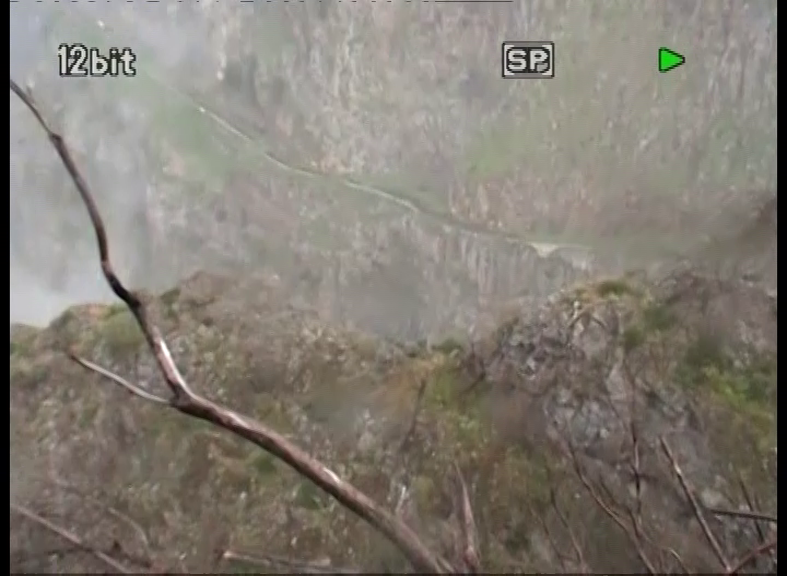 The old road cutting through a practically vertical cliff
The old road cutting through a practically vertical cliff
While we were transferring to the centre of Curral das Freiras, we first had to go down the road in order to pass through a small sort of valley and there the experience with the rainbow was fantastic again – as the road winded and went up and down, we drove for a short while seemingly beside a rainbow, then under it, then through it... A truly amazing effect. I had never seen anything similar before.
Then we parked the car and walked around the centre of the village.
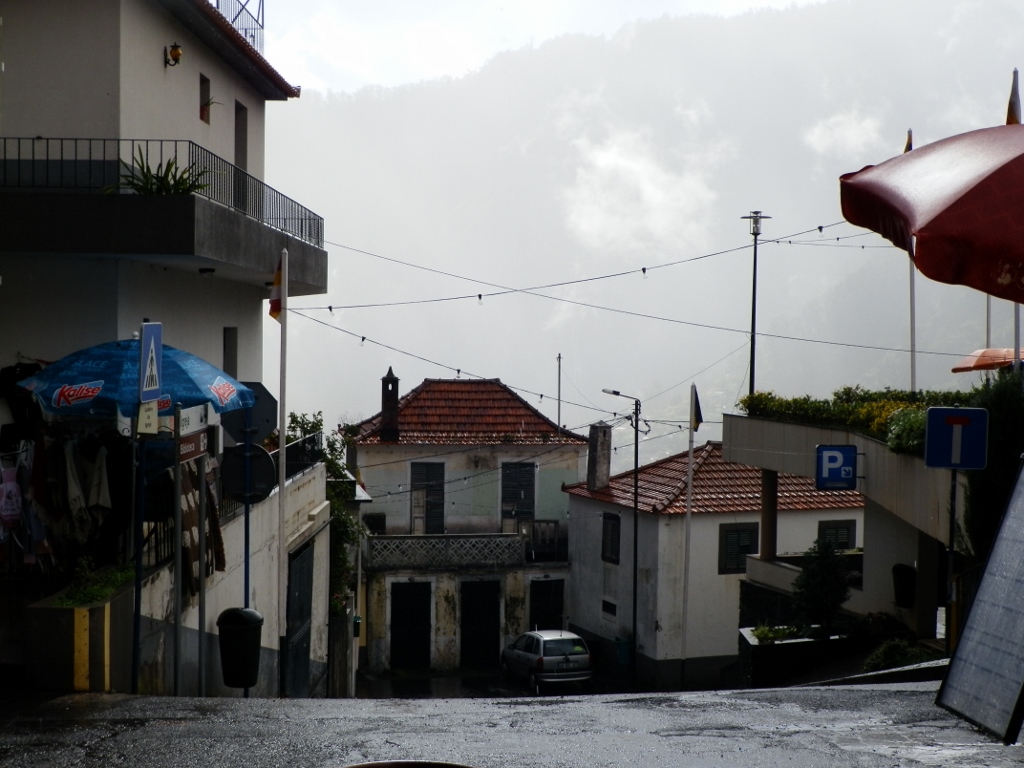 Centre of mountain village Curral das Freiras
Centre of mountain village Curral das Freiras
Although there are no nuns in the village, there are suitable ways to inspire visual memory of them.
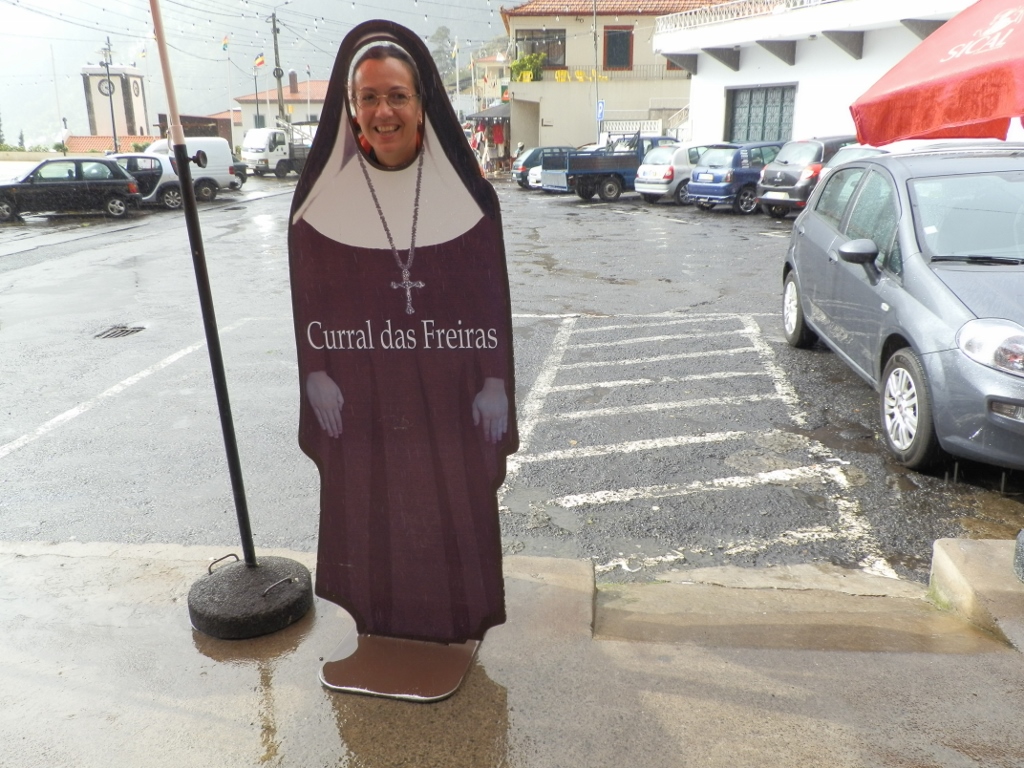 They don’t have my size, so I had to bend a little, but it turned out well
They don’t have my size, so I had to bend a little, but it turned out well
In the photo above, there is a bell tower of the local church behind me, so we walked over there to visit the church.
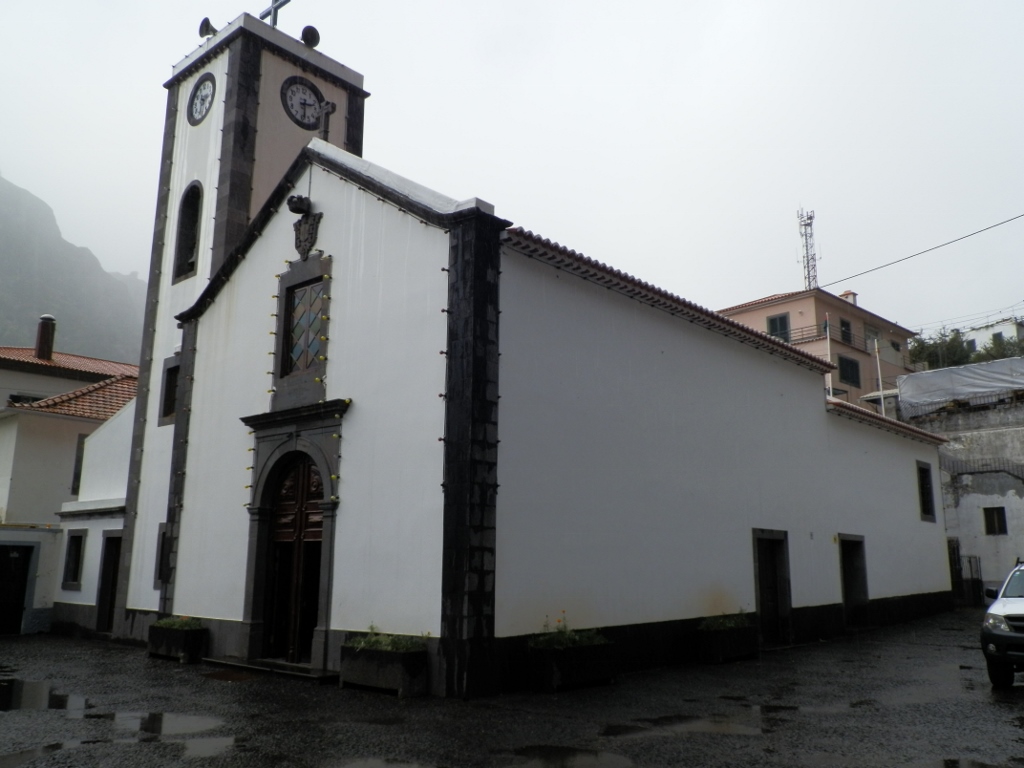 Church in Curral das Freiras
Church in Curral das Freiras
The church that can be seen here today was built at the beginning of the 19th century and when we entered it we could hear very nice, quiet and delicate spiritual choir music (female voices) and the impression was divine.
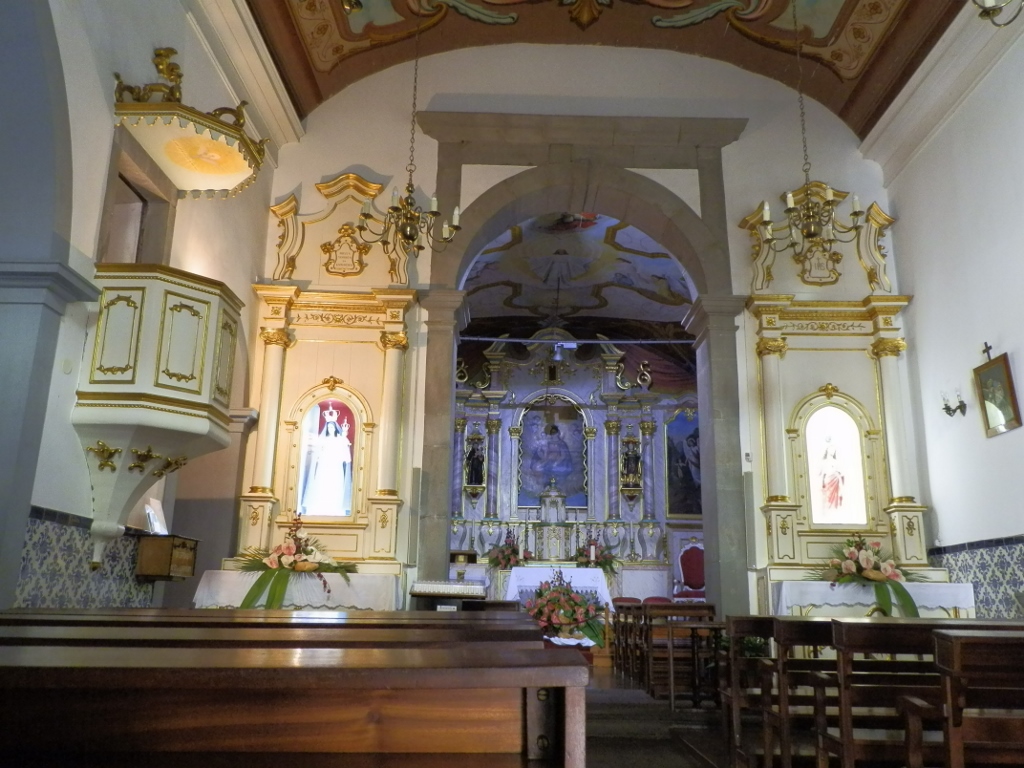 Interior of the church in Curral das Freiras
Interior of the church in Curral das Freiras
When we got out of the church it started to rain again, but there was still some sunshine. The weather was absolutely crazy!
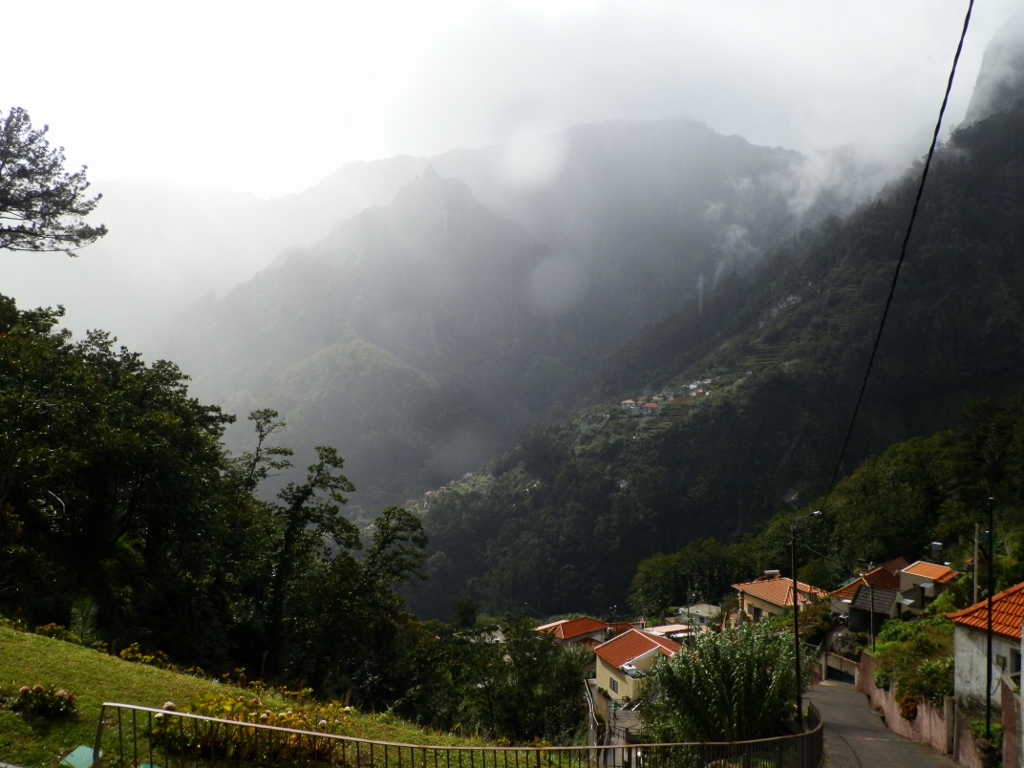 Crazy weather in Curral das Freiras
Crazy weather in Curral das Freiras
We used the time spent in the village so that I could also get acquainted with another local specialty and these were chestnuts and all things chestnut.
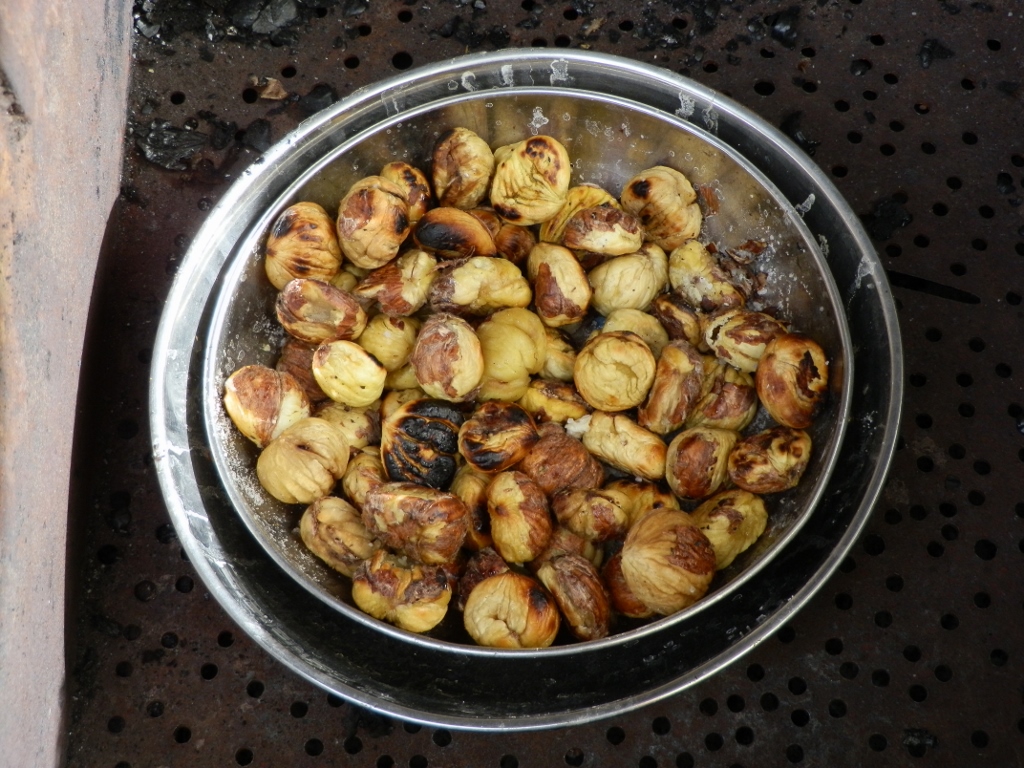 Roasted chestnuts
Roasted chestnuts
I have already mentioned chestnut liquor, but this village is better known for its chestnut tarts (Pastéis de Castanhas).
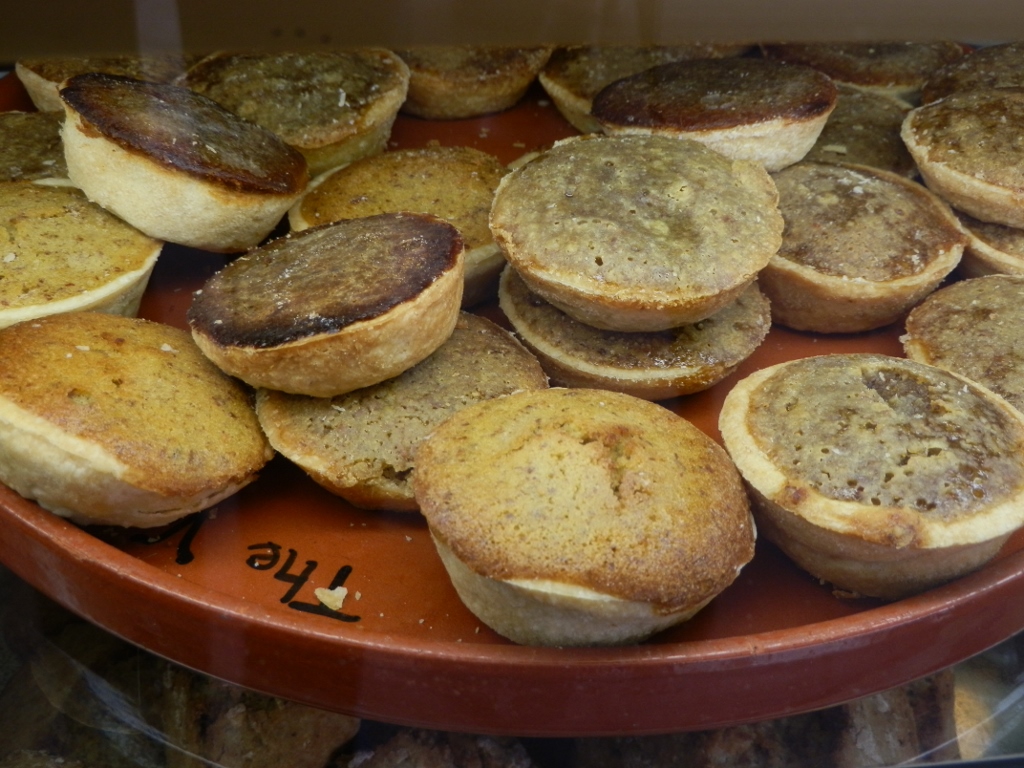 Chestnut tarts
Chestnut tarts
The chestnuts that grow here in abundance (grapes for Madeira wine are also grown locally) are used for making soups and other dishes and on 1 November there is also a Chestnut Festival organised here.
One more look at the lower sections of the valley and Joao and I were ready to return to the south side of Madeira and the embrace of the dry and sunny weather.
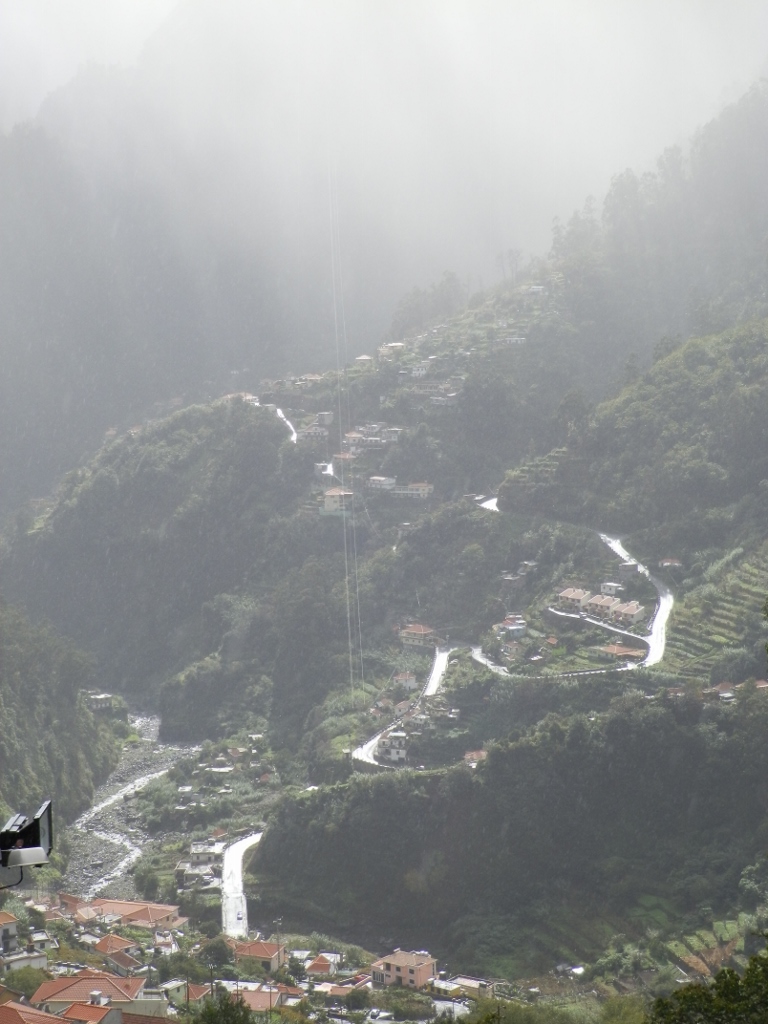 Lower sections of the valley near village Curral das Freiras
Lower sections of the valley near village Curral das Freiras